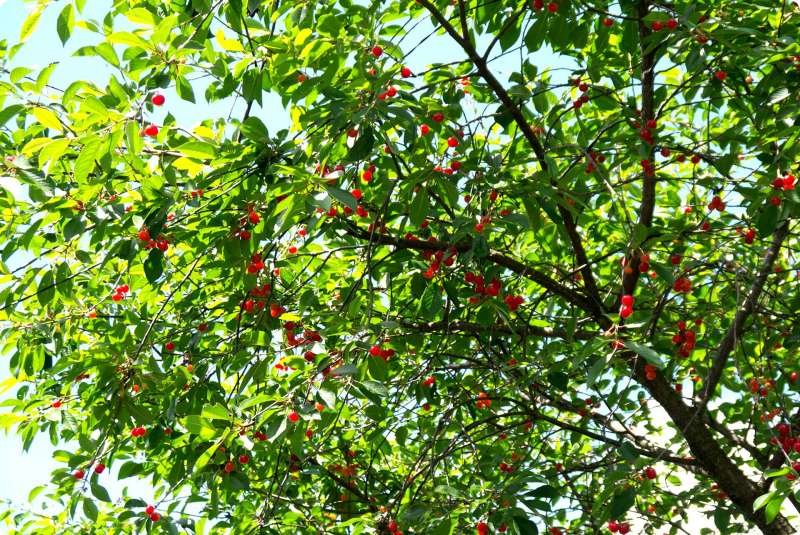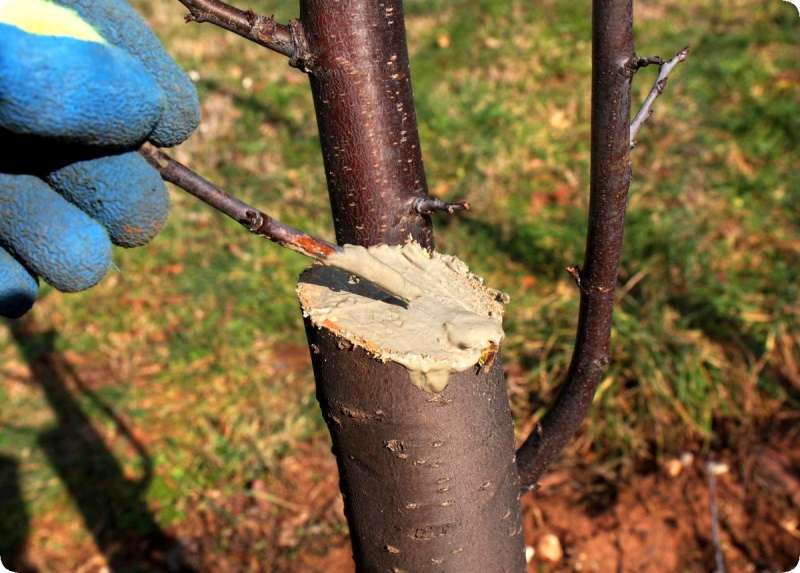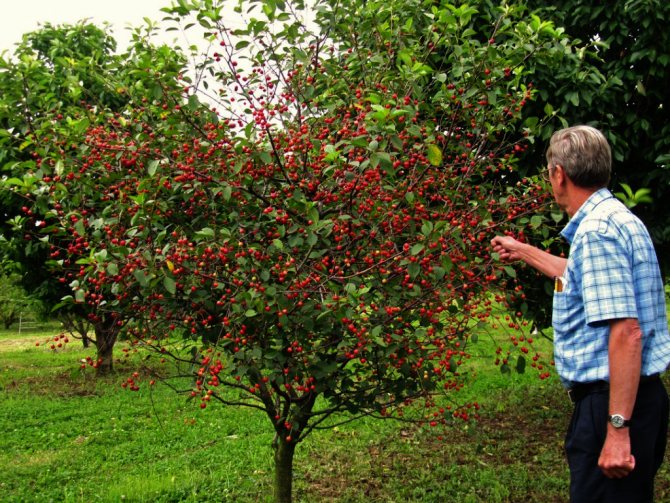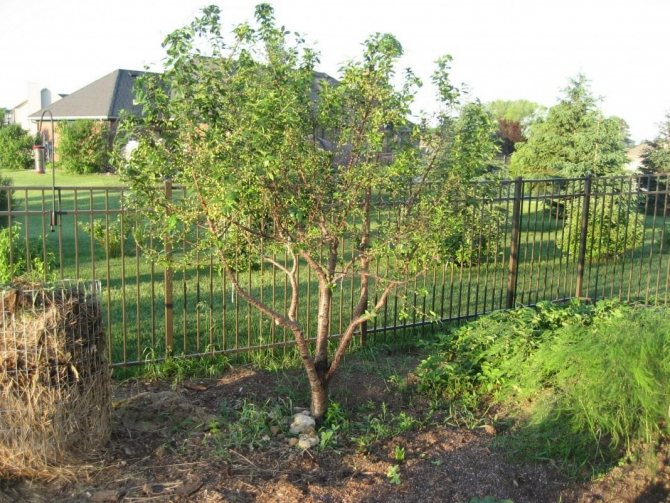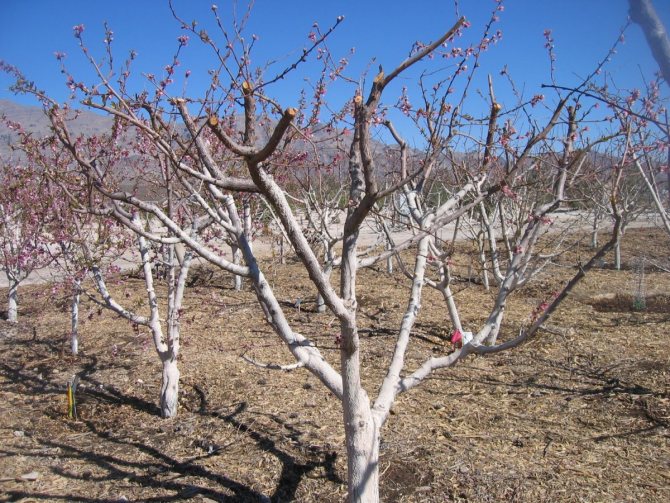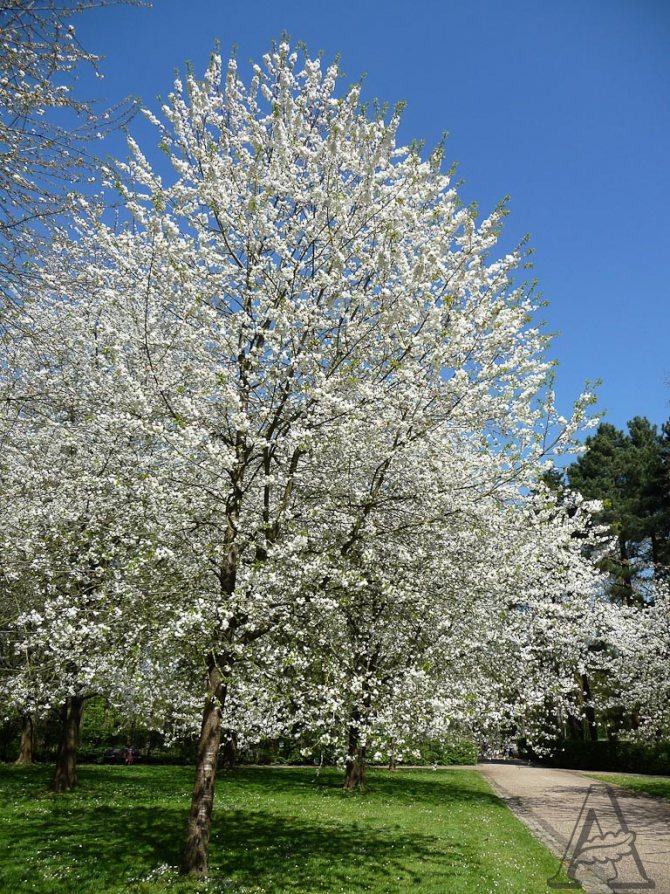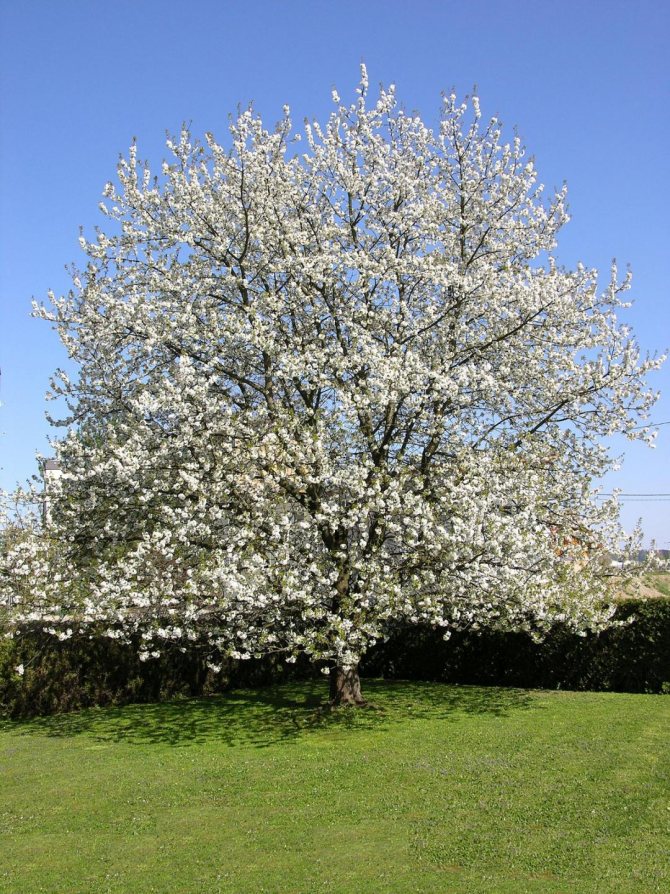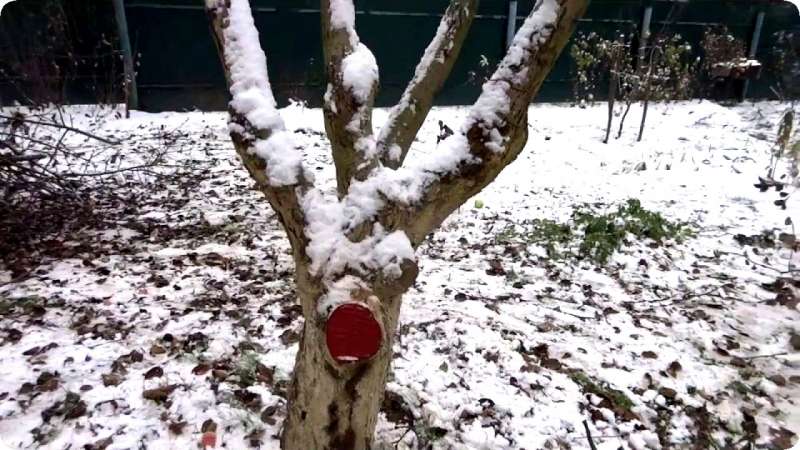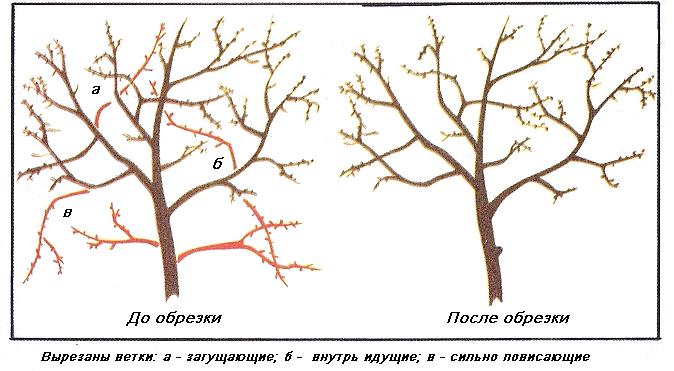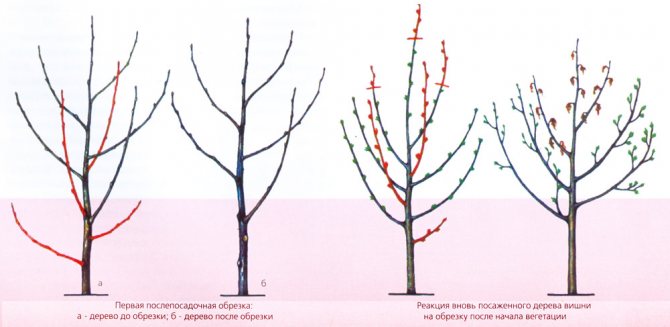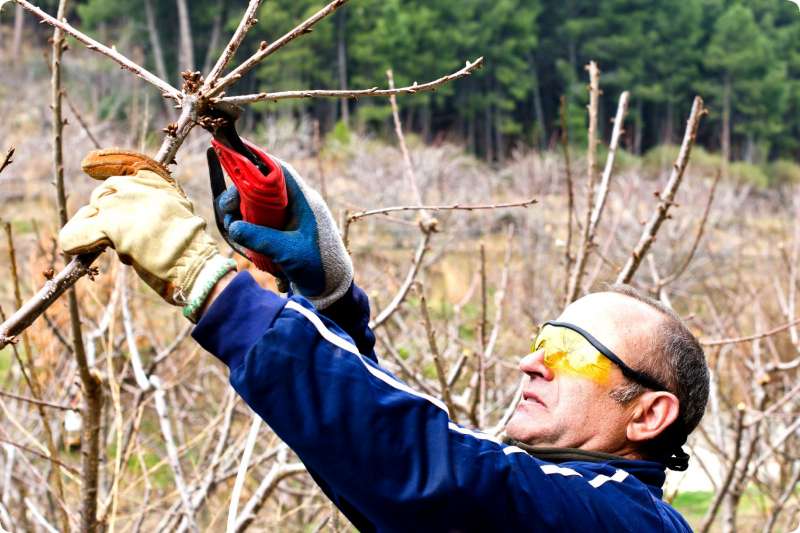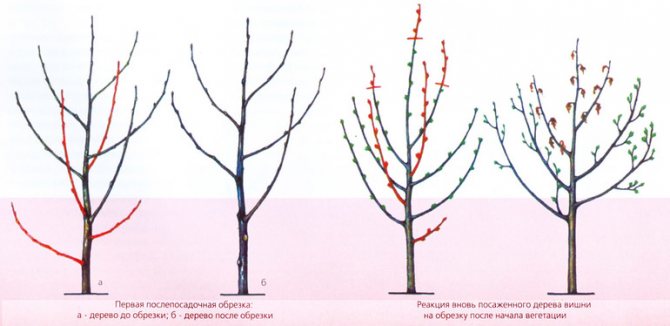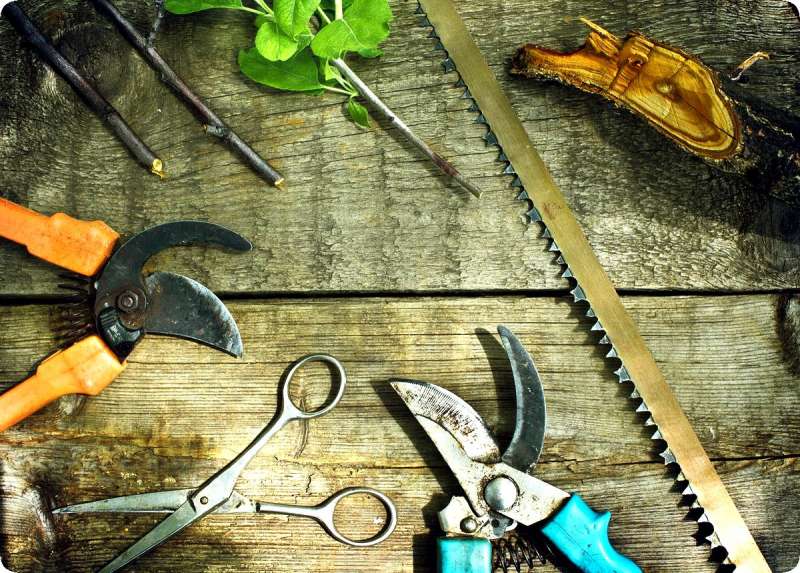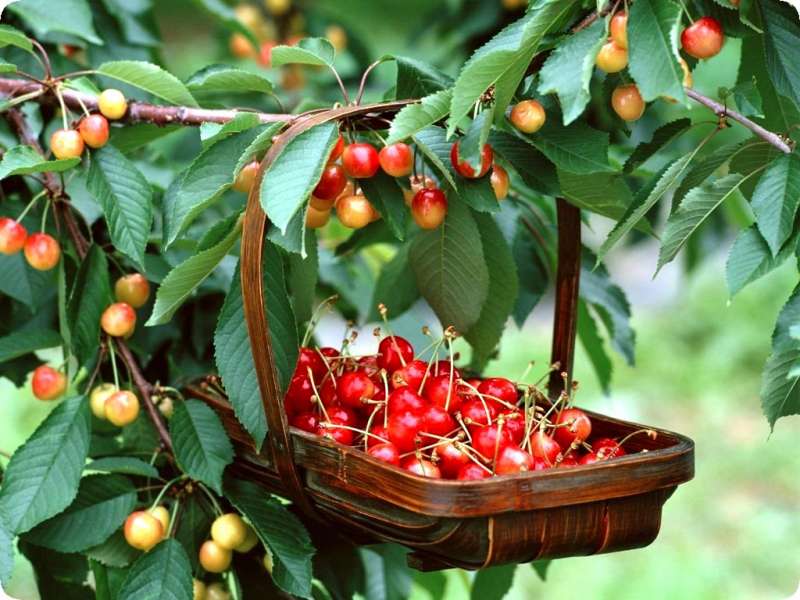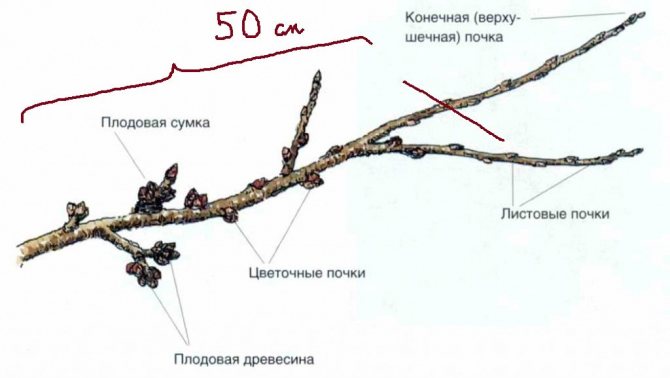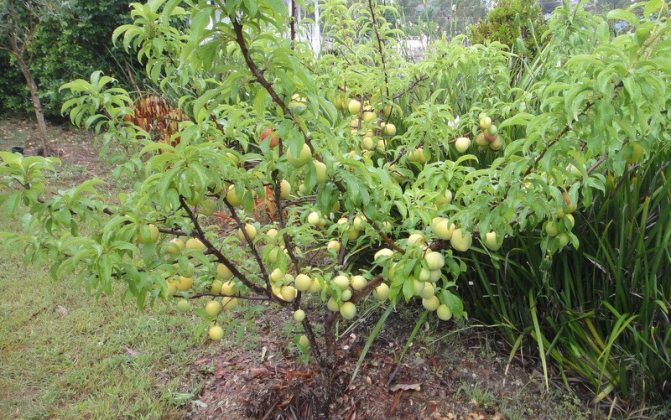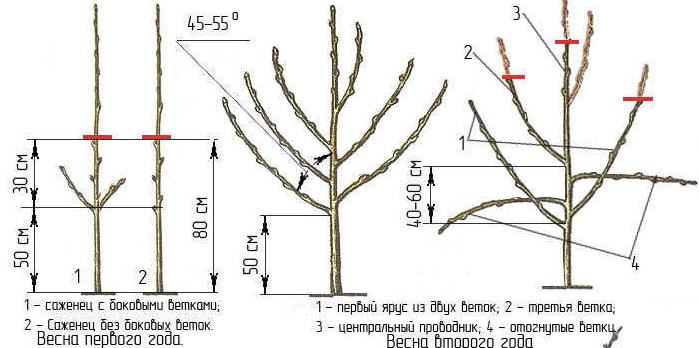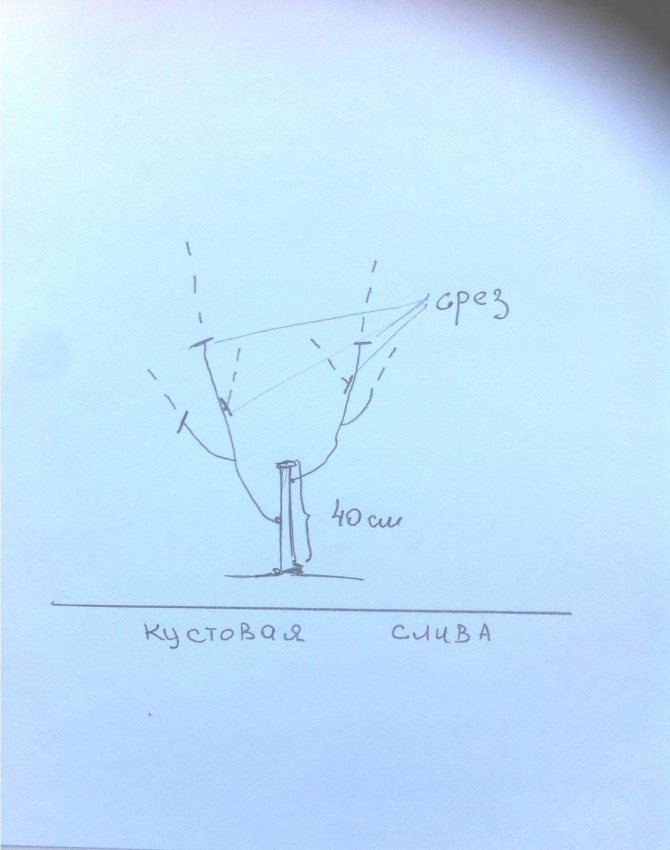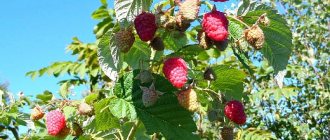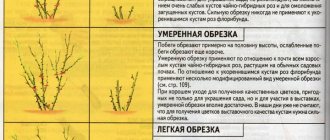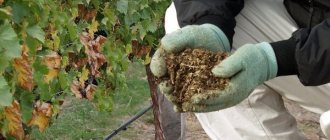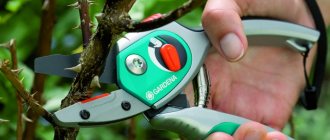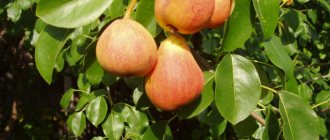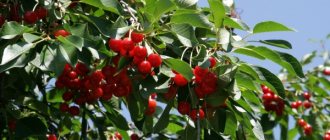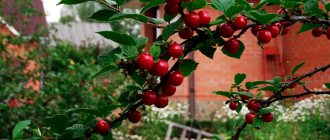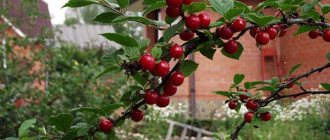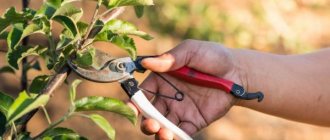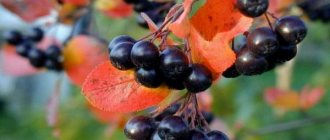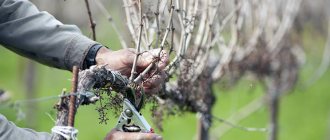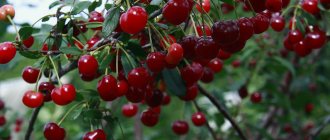The purpose of pruning plum
With a chaotic interweaving of branches, the tree becomes especially sensitive to negative temperatures. Frost forms on the branches, and they subsequently break. And as a result of multiple branches, the crown of the tree thickens significantly, a shadow is formed that interferes with the full development of fruits, the germination of young branches. After a while, the plant begins to dry out, it may even die. Accordingly, there can be no talk of a harvest.
Timely correct pruning of trees is primarily aimed at crown formation. This activity is carried out throughout the entire existence of the tree from the moment it was planted in the ground. This is the only way to allow the branches to develop correctly. At the same time, the tree acquires a more well-groomed appearance., and the fruits will be much more convenient to pick. Therefore, novice gardeners are interested in the scheme of how to cut a plum in autumn, spring, summer.
The tools you need
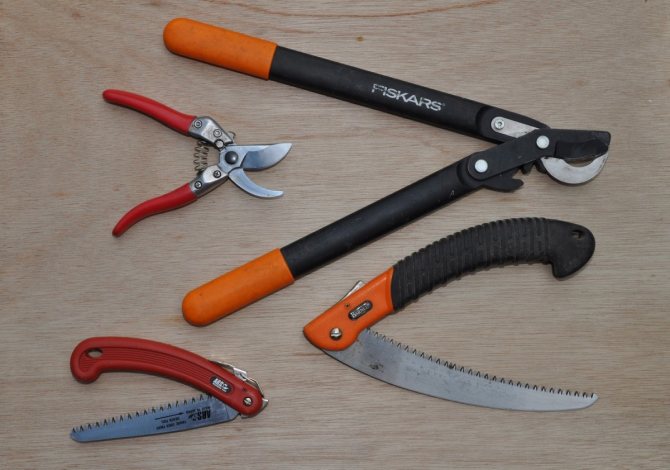
Required trimming tools
Pruning plums in the fall for beginners should be done with sharp, quality garden tools. In this case, the process will not cause difficulties even for a beginner in the field of gardening. So, take care of the availability:
- Secateurs about 2.5 cm thick... The bypass type is relevant for young branches, anviled - for dried up;
- Lopper up to 0.5 cm thick... This tool will help to penetrate into the deepest parts of the crown thanks to the long handles;
- Garden saw small and large for branches thicker than five centimeters;
- Garden knife.
It is important to process the cuts with a pitch. It needs to be prepared in advance.
Spring pruning
According to all the requirements of agricultural technology, pruning of plums after winter in the spring is carried out before the onset of the movement of sap in the tree.
Benefits:
- Pruning branches according to the pruning scheme of plums in spring is done well in advance of the onset of frost, when there is enough time to heal the wounds, to prevent the plant from damaging infectious diseases. Pruning plum branches in spring is recommended at the beginning of March.
- When pruning in spring, the plum will have time to form a young growth over the summer period, which will bloom next year.
For your information! The crowns of fruit trees must be cut in windless calm weather without precipitation. The event should be planned at a stable ambient temperature of + 10º for several days.
Plum shelter for the winter
Plum is a hardy plant, but it needs proper shelter at a young age. In the northern regions, insulation is carried out constantly, regardless of the age of the tree.
How to cover a plum for the winter - instructions and diagram
Plum shelter for the winter can be carried out according to various schemes. The most common application is the mulching method. After digging the trunk circle, it is necessary to mulch it with humus. After the first snow appears, a snowdrift is made from it around the tree, which contributes to insulation. It is also recommended to whitewash the trunk, which not only contributes to the warming of the culture, but also eliminates the possibility of the development of diseases and pests.
Features of the shelter of a young plum for the winter
Shelter of young plums is carried out according to a different scheme.This is because the trees planted this year do not need fertilization. That is why their insulation is carried out by whitewashing the trunk. And also around it you can wrap several layers of paper. The soil around the young plum is insulated with bags, which must be spread out and fixed with a small amount of soil.
If severe frosts are observed, then several layers of burlap must be used to insulate the trunk circle. The trunk circle should be covered with plastic wrap, which minimizes the negative impact of precipitation.
Summer pruning features
It is recommended to plan pruning of plums in the summer in June-July. The event is intended for young plants for the purpose of their sanitary treatment and further correct development.
Unlike the autumn pruning of plums, a similar procedure in the summer has its own advantages:
- The crown is covered with foliage and you can visually determine how thick it is. As a result, it is easier to define the scope of work and plan the pruning scheme.
- If diseased branches are present, during the warm season, the disease can spread to other fruit trees. Accordingly, pruning diseased branches in the summer, they carry out health prevention not only for one tree, but for the entire backyard territory.
For your information! According to the summer scheme, pruning begins from the moment a plum seedling is planted in the soil. In the first year, all branches are pruned by about 20 cm. Then, every year, all excess shoots are removed to the base.
Pruning technique and rules: tips for beginners
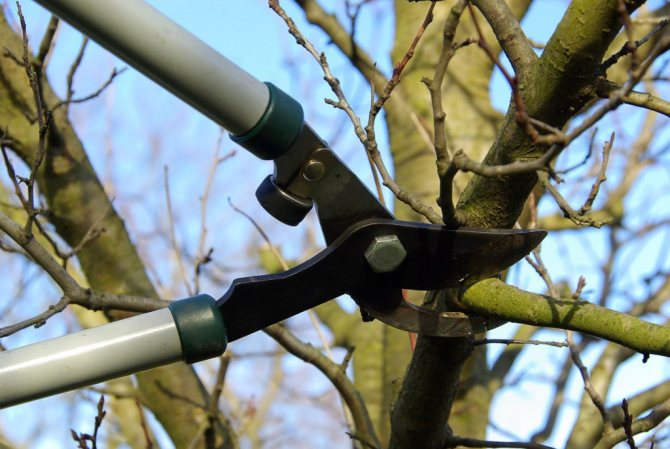

It is convenient to cut branches that are at a considerable height with a lopper.
The tree is trimmed in two ways:
- thinning - complete removal of a branch;
- shortening - cutting off only the crown.
Each tree needs both pruning methods. General scheme of the procedure:
- First, the shoots growing down and inside the crown are removed.
- Then the thickening branches are cut off.
- Sick, dry and damaged branches are cut out last. This is important as infection from the instrument can spread to healthy parts of the plant.
It is better not to cut small shoots, they are left on the tree until spring. When the branch is completely removed, a stump about 5 cm high is left near the trunk.
Pruning is carried out exclusively in dry weather, otherwise there is a risk of developing infections. If, according to forecasts, frosts are outlined in the coming days, it is better to postpone the procedure until spring.
Features of pruning depending on the type of cherry
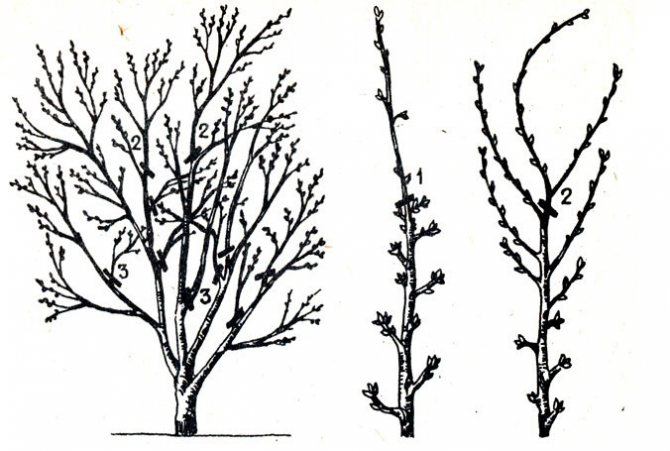

Cherry pruning: 1 - strong pruning; 2- pruning to a side branch; 3 - decimation
Thinning the crown of different types of cherries has its own characteristics:
- Treelike varieties require annual shortening of annual shoots. This stimulates the growth of side branches and ramifications on which fruits are formed. Also, growths on the outer and inner surfaces of large branches are removed.
- On bushy varieties, annual shoots are left unchanged: cutting them off can cause the entire branch to dry out. If the tree is prone to thickening, the branches are cut out at the trunk itself.
- Felt cherries are thinned out every year, leaving 10-12 branches. Annual shoots are not touched, since fruits are formed on them. An exception is branches 50 cm long, they are shortened by a third.
Nuances for trees of different ages
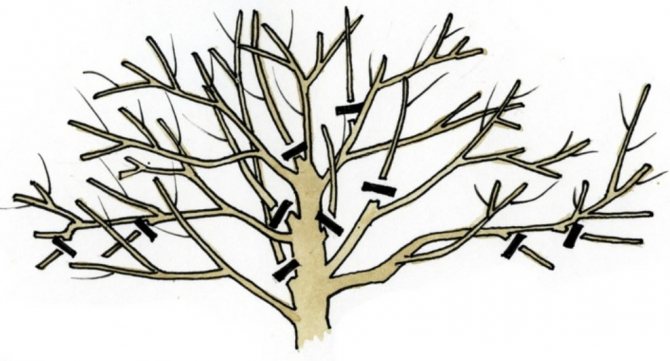

All branches thickening the crown of the tree must be removed
The pruning technology depends not only on the type and type of wood, but also on its age:
- In young tree-like ones, no more than 5 shoots are left. In bush plants - no more than 10. As the plants grow older, their number is brought to 15. Young specimens are rarely exposed to diseases and pests, so they do not need to remove damaged branches. When thinning, do not touch the branches that make up the skeletal base.
- The main purpose of sanitary pruning of old trees is to remove all diseased and withered shoots. If left behind, the young branches will have no chance to develop. Rejuvenating pruning prolongs the life of the plant.
- Fruit-bearing trees lose their strength, and their branches become bare. In order to have more berries next season, a third of the main branches are cut off by a meter. Annual shoots are mostly left. Branches that interfere with each other, growing in the wrong direction, are also cut off.
Autumn pruning scheme
In order to properly cut the plum in the fall, it is recommended to plan this event after the foliage has fallen off. At this moment, all the vegetative processes of the plant are completed, it gains tranquility. It is recommended to carry out this work in mid-September.
Advice for beginner gardeners! You should not postpone this procedure so that the plant has time to get stronger before the cold weather. Autumn pruning of fruit trees is not recommended in regions characterized by severe winters; it is better to postpone the event to the spring.
Autumn pruning depends on the age of the plant and consists of three stages:
- After planting the seedling in the soil for the first year, the central conductor is shortened by a third and the remaining branches by two thirds.
- Regulatory pruning is mandatory for plants of any age. In this case, the crown dilution is provided, the removal of all fast-growing, incorrectly developing branches.
- After the fruit trees reach the age of four, the rejuvenating procedure is carried out every next five years of life. During this procedure, all unnecessary old branches that have ceased to bear fruit are removed.
Autumn pruning is performed in September, when all the foliage has fallen, before the onset of cold weather. Pruning of plums in the fall after the first fruits is either not carried out at all, or only problematic branches are removed. An integral part of this period is sanitary pruning. In the process of this procedure, damaged and diseased branches are removed, which can lead the plant to death. Infected branches are recommended to be burned to prevent the spread of disease or harmful insects throughout the backyard.
Related article: Ash-leaved ash description and features
Favorable time for pruning
Each region has its own terms of the procedure:
- in central Russia, the Volga region, Moscow, Leningrad regions - this is September-mid-October;
- for the Urals and Siberia - no later than the end of September;
- in the south of the country, pruning is carried out in November.
Pruning cherry trees along with leaves is only possible in warm regions. In other areas, the procedure is carried out before shedding the foliage.
The main condition is not to wait for severe frosts, otherwise the winter hardiness of the plant will decrease. The branches are cut in dry weather, before the onset of cold weather.
Rejuvenation of the old plum
After a certain time of fruiting of the plum, the period of its rejuvenation is approaching, especially if its circumcision was not always carried out. The signal for the need for this event is a rare flowering, weak ovaries in the upper part of the crown.
Recommendations for rejuvenating old plums:
- After the tree reaches ten years of age, preventive crown thinning is carried out annually. All branches that have grown in the previous 4 years are cut down.
- To prevent damage to the crown, the lower branches are initially removed.
- Correctly make a saw cut near the branches, which will quickly begin to develop with the arrival of spring.
- Of the new shoots, you need to leave 3-4 of the most developed, and cut off the rest.
- It is not recommended to remove small branches, except for broken and infected ones.
- After the plum reaches fifteen years of age, its top is cut off, and the frame branches are shortened. They will subsequently be replaced by young shoots.
You cannot cut down all of the large branches at once.You need to get rid of them gradually over the course of 3 years. After the plant reaches 2.5 m in height, it is necessary to cut off the top of the central trunk and powerful lateral branches. As a result, the growth of the tree stops and you only need to control so that the sun hits the center of the crown.
Recommendation! In the process of rejuvenating the old plum tree, most of the wood suffers. Therefore, the wounds must be carefully cleaned with a knife and treated with special paint. Be sure to use potassium-phosphorus, nitrogen fertilizing.
Plum crown formation - schemes for beginners
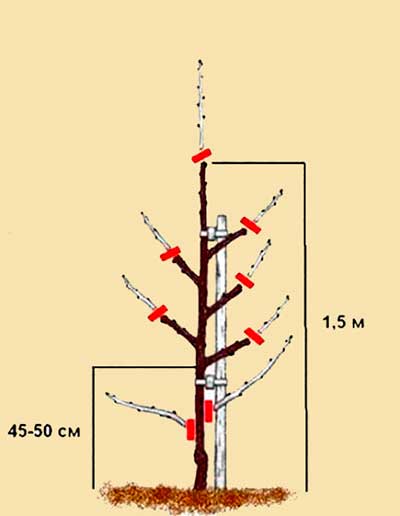

The crown of the plum is formed within 4–5 years, starting from the year of planting. If the seedling has branches: It is shortened to 1.5 m in height, above a well-developed bud. All branches and buds at a height of 45-50 cm from the ground are removed (future trunk).
The branches located above are shortened by ½ the length, making a cut for the kidney. A plum sapling that has branches is shortened One-year-old sapling that has no branches, form like this:
- The buds are removed at a height of 45-50 cm from the ground (future stem).
- Above, 5-6 buds are counted (in the spring skeletal branches will begin to develop from them).
- A cut is made into the kidney.
The formation of the crown in subsequent years can be carried out both in autumn and spring.
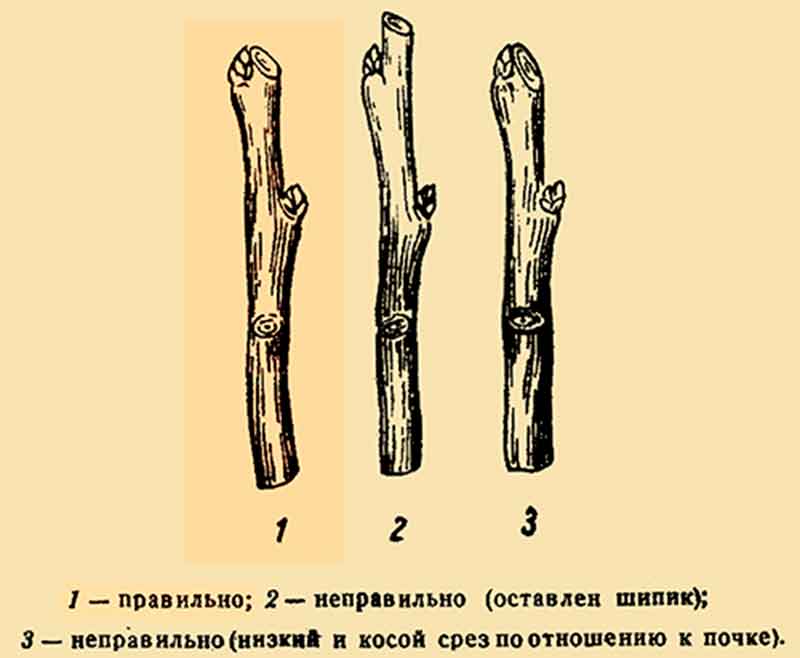

pruning the shoot on the bud
In the second year, it is done as follows:
- Remove those of the skeletal branches that will thicken the crown or grow down.
- Leave 2-3 strongest.
- The central shoot (guide) is shortened 15–20 cm above the bud, directed in the opposite direction to the bud, over which the cut was made last year.
This technique makes it possible to maintain the vertical growth of the conductor. In the second year, the central conductor is shortened by another 15–20 cm.
Procedure for the third year:
- Cut out all shoots that interfere with good lighting and ventilation of the crown.
- Shorten the growth of the current year by ⅓. The conductor is only stripped of forks.
- All the shoots that interfere with good lighting and airing of the crown are cut out from the plum.
In subsequent years, pruning is carried out according to the same principles. Only the top is completely cut out after the tree reaches a height of 2.5 m. This is done so that the plum does not grow too high - harvesting from tall trees is problematic.
Many varieties of plums can reach a height of 15 m without pruning. If the crown of the plum is formed annually, it will be convenient to harvest from it.
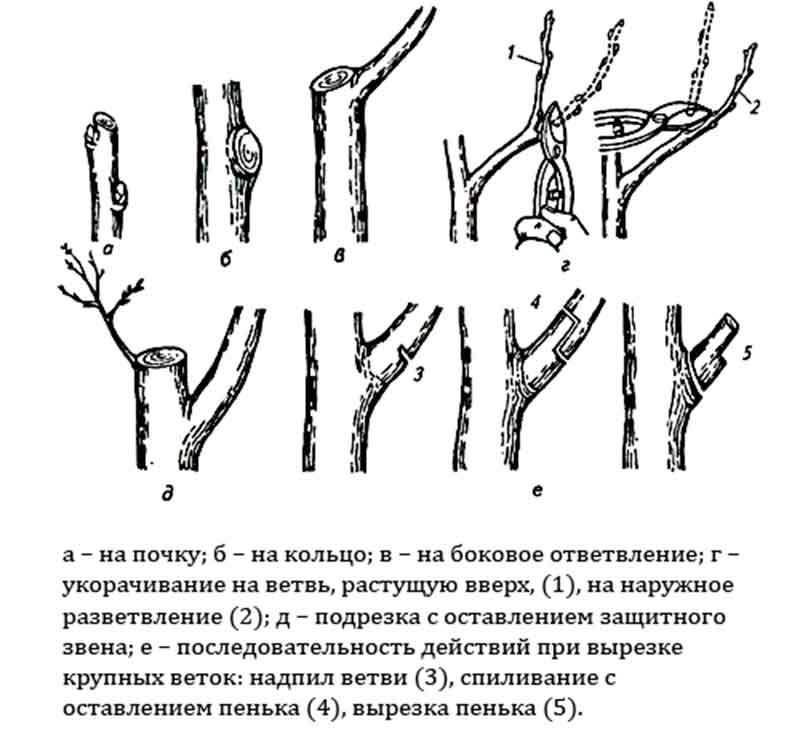

Pruning an adult plum
Trees whose crown was not formed in a timely manner, are put in order for 3-4 years.
They also do this both in autumn and spring:
- Reduce the height of the tree by ⅓ by cutting the trunk.
- Sick and broken branches are removed.
- The growth of the current year is being cut by half.
- The crown is cleared according to the general rules for pruning plums.
Next year:
- Cut out half of the non-fruiting branches and bring the height of the tree to 2.5 m.
- The growth is shortened by 15–20 cm.
- The crown is cleared according to the general rules for pruning plums.
- The plum trunk is shortened to 2.5 m, non-fruiting, diseased and broken branches are cut
In the third year:
Cut out the remaining old non-fruiting branches and shoots that have replaced the conductor. Form a crown on new skeletal branches. In the future, they maintain the shape of the crown, taking care of its good lighting and ventilation.
Plum, due to biological characteristics, tends to form many shoots. Pruning is one of the most important methods of growing a healthy tree that produces a stable harvest. Autumn pruning also helps to avoid damage to the plum in winter.
How to prune plums in the fall
Plum is an excellent stone fruit crop with many varieties created for different regions and different climatic conditions. This tree needs maintenance, an important part of which is pruning.Without such a procedure, the crown thickens, the plum spends an exorbitant amount of energy on the growth of useless and unnecessary branches, as well as growing a large number of too small plums, inferior to the fruits of a normal harvest in taste and useful qualities. In addition, autumn pruning is necessary as part of sanitation work prior to wintering.
Caring for a fruiting tree
As they "mature", cherries have a complex of problems that sooner or later the gardener will face:
- The growth rate of the plant decreases;
- Shoots are bare;
- Fruits ripen only on one segment of the crown;
- The lower branches begin to fade;
- Due to the dying off of the skeletal branches, the crown thins and decreases in volume.
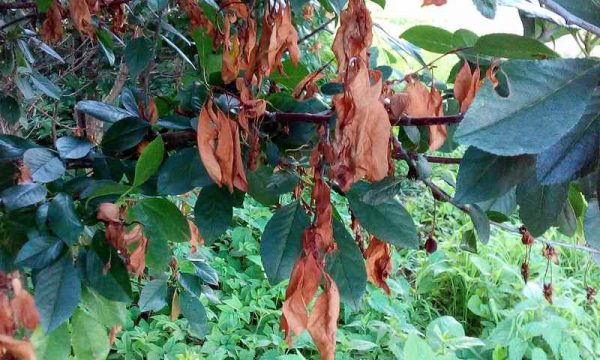

The wilting of cherries can be fought with the rejuvenation method
Mature and aging trees require increased attention from the gardener. Rejuvenation, which gives a "second life" to cherries, can help a withering plant.
Rejuvenation
To determine the degree of rejuvenation, it is necessary to build on the growth given by the plant in recent years. If the growth was small, it is removed up to the level of 5-7 years old wood. When removing the growth, incisions should be made on the lateral branch, so fresh shoots will grow not inside the crown, but outward. To free the center of the crown, shoots that unnecessarily thicken the plant should also be removed on the ring.
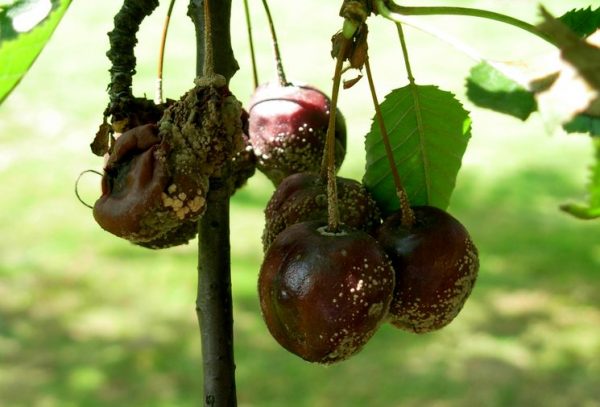

Rejuvenation helps to reduce the number of low-quality fruits
If the cherry has not been renewed for many years, it is better to rejuvenate it in several steps. There are some popular mistakes made during rejuvenation:
- Cherry shortening drastically. Despite the fact that cherry trees are quite tall, if you take more than two meters away from them at a time, there is a high probability that the plants will die. The wood should be cut in small portions, stretching the process for several years;
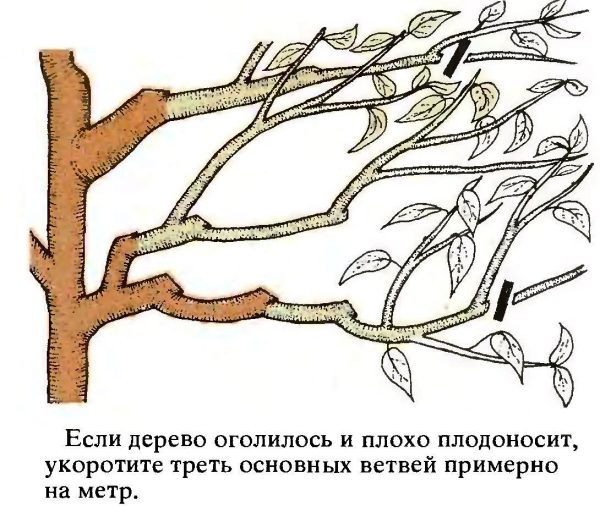

When a plant is rejuvenated, a significant part of the growth is cut off.
Do I need to prune plums in the fall
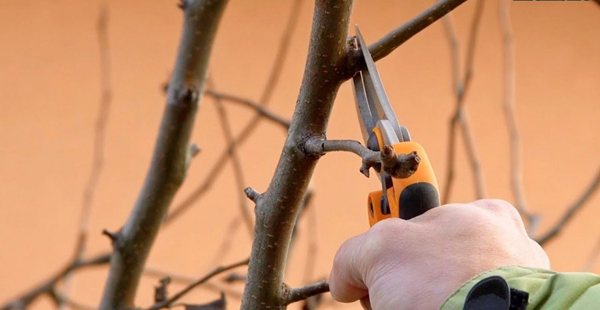

Whether it is necessary to cut the plum in the fall depends on the climatic zone, the type of tree, its age and other factors, in particular:
- the number of parts of the tree injured or affected by diseases or pests;
- the degree of thickening of the crown, etc.
This procedure should be combined with other measures to support the health of the tree and its fruitfulness. It is important to know that the timing and season of pruning for rejuvenating the tree and forming the correct crown depends on the region where the plum grows, but sanitary pruning can be done at any time, except for the winter period.
Features of plum care in autumn and in preparation for winter - general tips and tricks
In order to ensure a good harvest of plums for the next year, it is necessary to dig up the soil and at the same time apply the appropriate fertilizers. This procedure is carried out at a distance of one meter from the tree trunk. The soil should be dug to a depth of no more than 30 centimeters.
By the way! Digging the soil can be carried out only the next year after planting the crop.
There are several types of fertilizers that are allowed to be applied under the plum in the fall. In most cases it is recommended application of a mixture of humus, wood ash and superphosphate... Gardeners also advise adding small amounts of urea.
Plum belongs to the category of moisture-loving plants, therefore, she needs to provide abundant watering in the autumn. At this time, appropriate fertilization is required. For the procedure, it is desirable use at least 35 liters of water... Watering is carried out until severe frosts. Otherwise, it can negatively affect wintering.
A variety of pests can be found under the hidden scales of the tree bark. To eliminate them, it is recommended to carry out cleaning the tree trunk from scales. For this purpose, it is advised to use a special stiff metal brush. During this procedure, you should have a number of insecticides, the action of which is aimed at eliminating pests. If they are found, there is a need for mandatory spraying of the plant.
Preparing plums for winter consists in whitewashing the trunk, which provides protection from pests and limits the possibility of negative effects of sunlight on the tree in winter. For this procedure, it is optimal to use a solution of lime and mullein.
Video: how to prepare a plum for winter
When is it better to prune - in spring or autumn
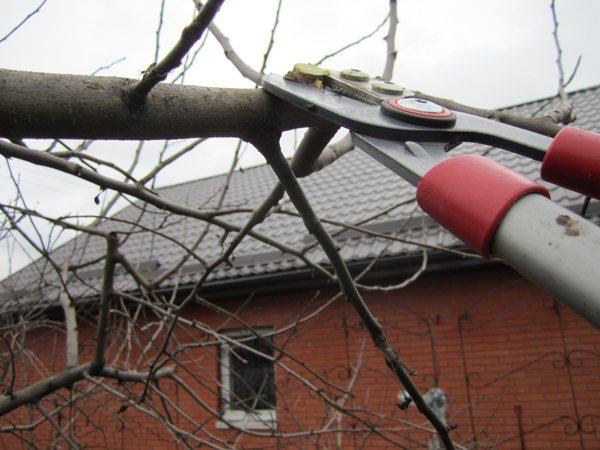

Most fruit trees are pruned in the fall, this is the optimal time for this procedure, since before winter sap flow in the tree slows down, all processes associated with life "quieten down" so that you can calmly plunge into hibernation. In this state, "blood loss" during pruning is minimal, the tree is not exposed to severe stress.
Other reasons why pruning is best done in the fall:
- At this time, pests and pathogens that huddle in the bark and other parts reduce their activity, and therefore damaged and affected branches are removed with the least risk that the parasite can move to a healthy part and hide there for the winter.
- Pruning the crown in autumn will protect the tree from breaking branches in winter under the weight of snow: the thicker the crown, the more snow lingers on it. Correct pruning will maximize the shape of the crown, enhance its "streamline".
- The density of the crown of an unkempt tree leads to multiple damage to the branches and trunk, and the damaged bark and even more so the wood is, firstly, a threshold open to infections, and secondly, a wound from which juice flows.
- Pruning in the fall is essential for good preparation for winter: when the bulk of the nutrients go to maintain skeletal branches, the tree will winter better and tolerate the cold.
Spring pruning is recommended for regions where winters are long and cold. Here, pruning in autumn can lead to the plum tree losing a lot of strength and not being able to withstand the winter cold, and in the worst case, it will die.
Notes, hints and tips
For those who are just starting to prune cherry trees, it will be useful to heed the recommendations of experienced gardeners:
- Before the formation of the crown, the top of the trunk is filed to the optimum height and only after that the crown is cleared of unnecessary shoots.
- If in doubt, which branches to cut, then look at the buds. Branches with fewer buds are cut off.
- An excess of unnecessary branches from one tree is removed over several seasons.
- Young cherries are not cut off too much, otherwise the fruit will become smaller.
- The branches of a biennial tree that have grown more than 60 cm are shortened by a third.
- Horizontal branches give a good harvest of berries. It is necessary to ensure that they grow upward.
- Shoots of the first tier growing down are pruned.
- To increase yields, the growth of the tree is limited to 3 m. At the same time, it is observed that the central stem is 20 cm higher than the upper branches.
Some summer residents are guided by the lunar calendar before pruning. The days are considered auspicious when the moon decreases and before the new moon.
It is useful for beginner gardeners to study the device of a cherry tree, to learn to distinguish between growths, vegetative and bouquet branches.Pruning correctly helps cherry trees withstand the cold winter more easily and increases their lifespan.
0
When to trim
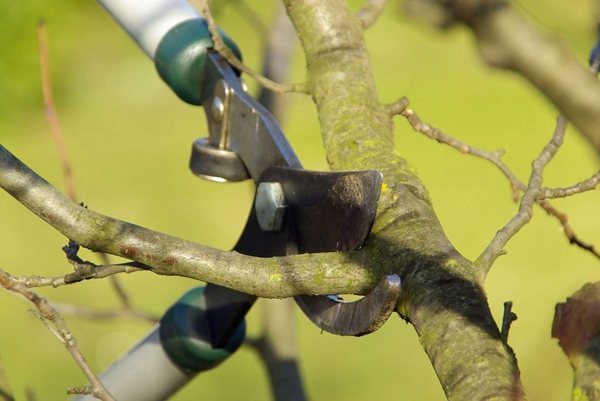

The general recommendation for pruning plums in autumn is that this procedure should be carried out after the complete end of leaf fall, when the branches have lost all leaves. In terms of calendar dates, these are approximately from mid-September to mid-October - depending on the region. Leaf fall means that the tree is already ready for wintering and is at rest. In different regions, foliage falls at different times.
In the suburbs, Central lane
Specialists in stone fruit crops advise to cut the plum in the autumn in the Moscow region and the Middle lane only if necessary, and it is better to postpone the procedure until spring. But in the case of a large amount of damage or a heavily thickened crown of a neglected, unkempt tree, the risk of getting broken branches or a tree dying from a disease or pest at the end of winter is greater than the possibility that the plum will not winter well.
In the Urals, in Siberia
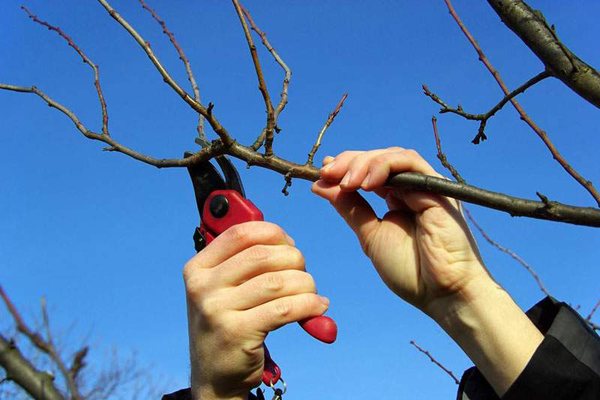

Spring pruning is also strongly recommended in the Urals and Siberia. When pruning plums is carried out before the tree begins to vegetate, the culture has all the conditions for full recovery in the spring and summer, and after that there is no need to be afraid of how the plum will overwinter, even if the forecasts promise a harsh winter with frost. But if, nevertheless, the need for autumn pruning arose, then you need to carefully protect the tree from frost.
Related article: Sal description and features
Leningrad region
Since the Leningrad Region does not belong to regions with warm winters, it is necessary to cut the plum in this area at the very beginning of spring. If for some reason the gardener did not have time to do the spring pruning, then it is best to postpone this procedure for a year, until next spring. When it is not about rejuvenating or formative pruning, but the need to remove branches for sanitization arises, the procedure is performed after the leaves fall.
Why prune cherries in the fall?
In autumn, pruning is carried out for the purpose of thinning and sanitation. Subject to removal:
- sick, old, dry branches;
- vegetation at the base of the trunk;
- shoots that grow inside the crown;
- dense, intertwined processes.
Together with the affected branches and debris, bacteria, insects, and fungal spores are removed from the leaves. This eliminates the possibility of wintering for pests.
After sanitizing treatment, the tree and the trunk circle are sprayed with a 5% urea solution. This fertilizer destroys pests, fungal and infectious pathogens.
Overgrown trees are thinned out to form the correct crown, unhindered penetration of sunlight and air.
In the fall, cherries are dormant, so pruning is easier. In the spring, active sap flow begins, buds bloom. Any interference with this process can cause gum flow.
How to properly prune for beginners
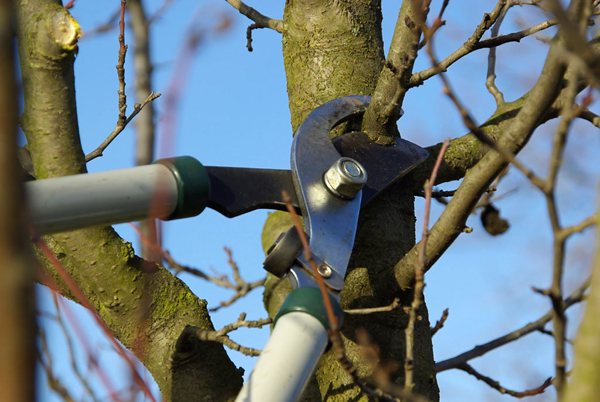

For beginner gardeners, it is enough to know the simple rules of pruning so that the tree does not suffer as a result of this procedure, and the pruning itself has fulfilled its purpose.
- Do not start pruning before the leaves have fallen off.
- The branches are very long, and also fast-growing - the first candidates for breakage from gusty winter winds and excessive snowfall. Such parts of the tree should be shortened by one third of their length.
- It is necessary to distinguish between formative, regulating, rejuvenating and sanitary pruning: formative and regulating are produced in young trees (plum is considered as such until it reaches 15 years old), rejuvenating in old ones (after 15, respectively), and sanitary pruning does not depend on the age of the tree.
- When pruning, branches should be cut strictly to the length indicated for this type of pruning. Cutting at too high an angle can cause the wood to crack. It is best to cut slightly obliquely.
- The pruning itself is best done with a pruner or other sharp garden tool with a straight blade. Do not use a garden saw or other tools with serrated or scalloped blade edges, as they severely injure the tree. The edges of such sections do not heal for a long time, pathogens enter them, and gum leakage is observed. The pruner is not suitable only for old skeletal branches: they will have to be cut down.
- Any cuts, even with the smallest diameter, should preferably be processed, preferably with garden varnish, but you can use oil paint or special substances.
Adult plum


For old wood, you will need anti-aging pruning. Its essence is to remove old skeletal branches. In the spring, young fresh shoots (hence the name of pruning) will appear at the places of the cuts, which must be thinned out, leaving no more than four of the most durable and promising ones. Thinning in the field of cuts of skeletal branches is done in July and early August.
Experienced gardeners warn that pruning too many branches in one procedure can be detrimental to the tree: the plum may not withstand such severe stress and die. Therefore, it is necessary to space this procedure in time for 2-3 years, cutting off several old branches every autumn, and not all at once.
Pruning plums in autumn: video
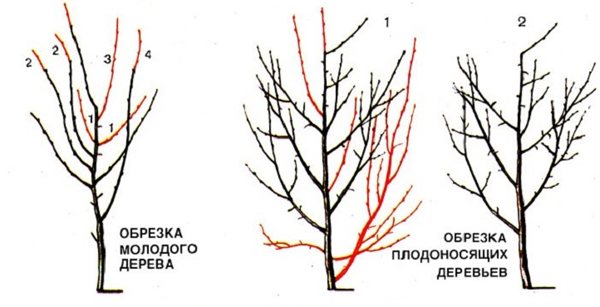

The young plum is pruned at the time when the tree sapling is planted. Further, regulating and shaping pruning is applied. The crown itself is formed over 15 years, after which young shoots cannot be pruned, this procedure is applied only to dried and diseased and pest-affected branches.
Formative pruning is needed to obtain an optimal crown shape, which helps the tree to winter well and does not break under the weight of the snow that has fallen, contributes to good ventilation and better lighting. Such conditions contribute to greater resistance to disease-causing factors and increased yields. In addition, a good, unfiltered crown is much more convenient for harvesting.
To form a young plum crown, it is necessary to leave 5-6 strong branches, the minimum distance between them is 20 cm.The angle of the skeletal branches in relation to the trunk should be about 50 degrees, this is a guarantee that the plum will be well ventilated and receive enough sunlight. The thickened crown makes the plum freeze even with slight cold. The top of the tree is also shortened if necessary.
Columnar
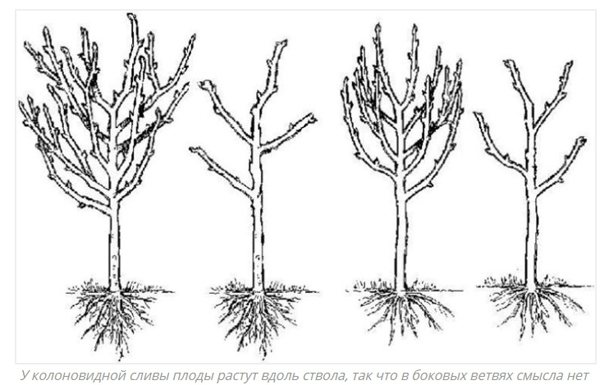

The columnar plum has a compact crown, and the fruits themselves are grown along the trunk, unlike other trees, where spreading branches with fruits grow. A columnar tree does not need side branches, so they must be pruned every year.
The main thing is to ensure the safety of the central conductor, which does not affect trimming at all. When its top freezes, the tree will "throw out" 2-3 additional shoots in this place in the spring. It is necessary to leave one of them, the strongest and strongest.
Care after pruning
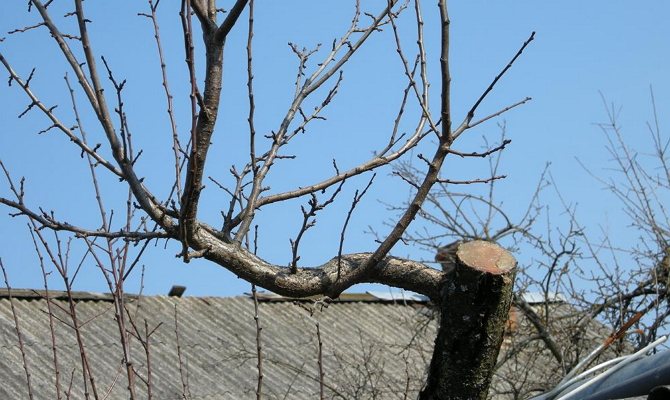

For better tolerance to plums of such procedures, it is important to learn how to perform the correct cuts. They need to be done at an angle of 45 degrees. Moreover, the last kidney should be placed at a distance of 10 cm from the edge of the trim.
All such actions must be performed only with the use of sharp, as well as disinfectant treated garden tools (saw, knife and lopper).
Wounds on the drain, so that they overgrow faster and do not become infected with infections, must be cleaned with a sharp knife, and then treated with copper sulfate. After that, it is required to lubricate the damaged area with oil paint or garden varnish.
The following top dressing will help to improve the regeneration of the plant:
- Wood ash. It needs to saturate the rhizome, which will provide the supply of nutrients and reduce the acidity of the soil.It takes about 200 g of substance under one tree.
- Potassium. The element helps to remove excess liquid from the trunk and shoots, it prevents the winter freezing of the tree. You will need 100 g of dry composition for a bucket of water under each tree.
- Phosphorus. The element is necessary for strengthening the roots, assimilation of sugar and protein compounds. Its consumption per 1 sq. m is 50 g. The product must be sprinkled around the trunk.
In addition, it is important to carry out other recreational activities:
- Autumn plum care also includes mulching. After fertilizing the soil around the trunk, cover the ground with mulch, burlap and dig in a little. This procedure will provide the roots with warmth, retain moisture in them and prevent the rhizomes from freezing.
- To protect the trunk from pests and diseases, it must be whitewashed with mullein, lime or clay. You can also add copper sulfate to the composition. First, you need to go through the trunk of the plant with a brush or scraper, remove the old bark and growths, and then whitewash, distributing the material evenly over the surface of the trunk.
How to properly prune plums in the fall
Related article: Acacia verticulata description and features
Almost every amateur gardener grows on the site of a plum - one of the most popular fruit crops. The fruits of the plum tree are eaten fresh, they are used for homemade preparations for the winter - compotes, jams, preserves, jellies, sauces and marinades. However, in order to get a consistently high yield of fruits, you need to properly care for the plant. The topic of our article is autumn pruning of plums. We will tell you when to prune a plum after fruiting, how to prune a plum in the fall, what the correct pruning of a plum means, whether it is possible to prune a plum in the year of planting and how to prune an old plum.
Tools for work
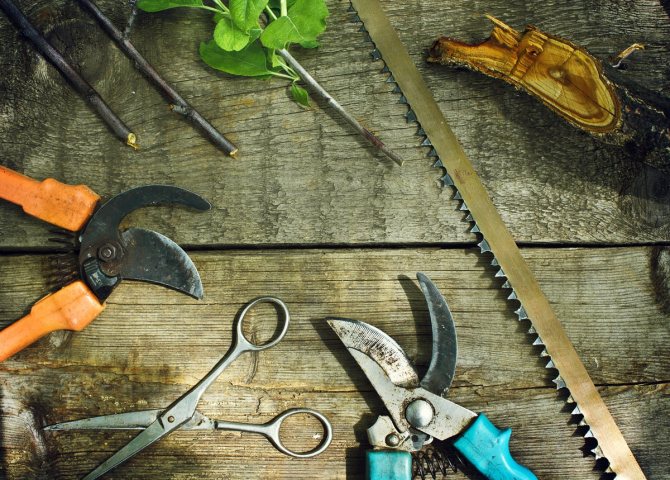

Disinfect tools before pruning
Interested in how to properly prune cherries in the fall, do not forget that only high-quality sharp instruments are needed for the procedure. In order not to infect the tissue of the tree, they are pre-disinfected. Experienced gardeners are advised to prepare the following inventory:
Recent Entries
Rose Petal Jam and Its 7 Health Benefits You Likely Didn't Know About What Fruit Are You According to the Zodiac Sign The 11 Best Grape Varieties That Will Help You Create Unique Homemade Wine
- secateurs for thin shoots;
- garden saw or hacksaw for thick branches;
- lopper for cutting off branches at a considerable height;
- garden knife for grinding slices.
When can a plum be pruned
The main pruning of plums (sanitary and formative) is carried out in early spring, in March, when the winter frosts remain behind, but before the buds swell on the trees. If you cut plums at a temperature of -10 ºC and below, the cuts on wood that are fragile from low temperatures will not heal well.
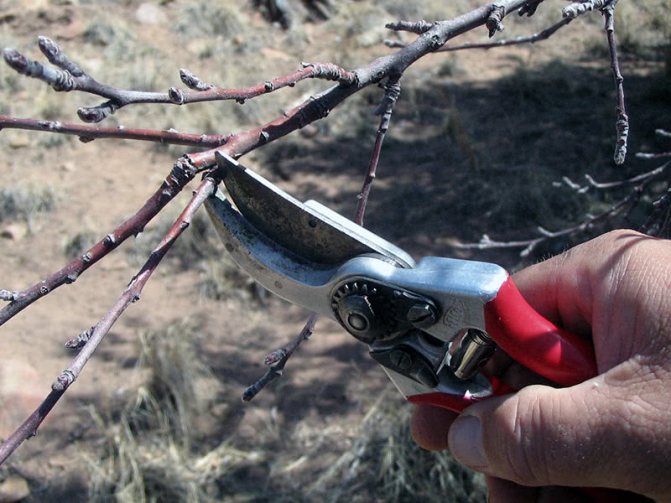

You can prune plums in the first half of summer, when the sap flow in the plant slows down. The purpose of summer pruning is to help the tree cope with the harvest by preventing branches from breaking off.
Autumn pruning is performed after leaf fall, when all vegetation processes are over in the tree. The purpose of the procedure is to prepare the plum for wintering.
In winter, when the air temperature on any day can drop to significant minus indicators, it is better not to prune.
How to take care of the tree after?
In order for the plum to endure the pruning procedure as easily as possible, to begin with you need to learn how to make the right cuts, which should be performed at an angle of 45 degrees, and the last kidney should be at a distance of 5-10 centimeters.
All such work should only be carried out using a sharp and disinfected gardening tool such as a knife, saw and lopper.
In order for the wounds on the tree to grow faster and not to undergo various diseases, initially they are cleaned with a sharp knife and treated with copper sulfate. Then they are lubricated with garden varnish, oil paint or any other regenerating agents.
Pruning plums is a rather complicated process only in the initial stages.while the crown is forming. At a later date, all work is reduced to the regular removal of old, damaged or improperly growing branches.
Plum is a delicate and sensitive tree. However, you cannot do without pruning, otherwise many new branches will appear, the crown will thicken and the yield will decrease. Therefore, pruning plums in autumn and spring is a must for gardeners looking for a healthy, fruitful tree.
Is it possible to do without autumn pruning of plums
During autumn pruning, you free the tree from unnecessary branches that burden it, thereby eliminating the need to spend energy and food on them. The plant recovers faster, tolerates frost well and will bear fruit better next year. Moreover, By removing branches infected with diseases and pests, you preserve the health of the plum. If you postpone pruning to spring, overwintered pests and infections from the beginning of the next season will begin to destroy the tree with renewed vigor.
Many gardeners prune plums once a year - in spring, but it should be borne in mind that sometimes spring comes suddenly, the sap begins to boil early in the plants, and you may simply not have time to prune before the sap begins to flow. In this case, your plum will start the season with too long a conductor, with an unkempt, thickened crown, in which pests and infections are likely to have already settled. The unsatisfactory condition of the tree will certainly have a bad effect on its fruiting: the plums will be small, and there will be less of them than they could have been if you had carried out an autumn cleaning.
Pruning depending on the shape of the tree
Cherry trees are of two types: treelike and bushy. The formation of the crown and the location of the fruits occurs in different ways, therefore, care has its own nuances.
In bush varieties, flower buds are located only on annual growths, and in tree varieties - on growths of previous years, bouquet twigs, annual shoots.
Bush cherry
Bush cherry varieties thrive in summer. In the fall, the crown is carefully thinned out. Shoots, dry and affected branches are also removed. In order for the plant not to lose its strength and yield, the following conditions are met:
- young shoots are not cut off (the branch may dry out);
- the branches of the crown are directed outward;
- bushes up to 50 cm long are left intact;
- the bare ends of the branches are cut off by 30-50 percent of the total length;
If the growth of bush cherries is less than 20 cm per year, intensive cleaning is carried out.
Tree cherry
The height of such a tree can reach 5 meters due to strong skeletal branches, therefore, in addition to thinning, it is shortened at a young age.
Unlike bush cherries, annual shoots are pruned in tree ones. This stimulates the development of lateral branches. Gardeners prefer a combined or sparse-tiered system when caring for tree varieties.
Autumn pruning plum
The main task of autumn pruning is to free the plum before winter rest from broken, dry branches affected by disease or pests.
The conductor of an adult plum is shortened to 2.5 m. For a seedling planted in spring, the conductor is cut by one third, and the shoots coming from it - by two thirds, so that they do not interfere with each other. Then, on two-three-year-old trees, competing and actively growing shoots are shortened by 1/3 of the length, which in the future will make the crown too thick. On mature trees, shoots are shortened in the spring.
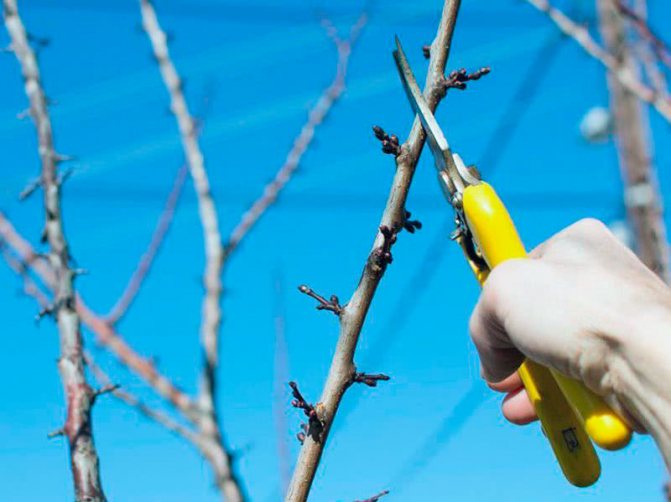

All cuts and cuts, the diameter of which is more than 5 mm, must be covered with garden varnish or Ranet paste.Plant residues, like fallen leaves, must be immediately removed and burned, since they can be infected with harmful microorganisms and pests that have settled down for the winter. Or if you have a garden shredder, use it to chop up the cut branches and place them in the compost pit.
List of tools and materials
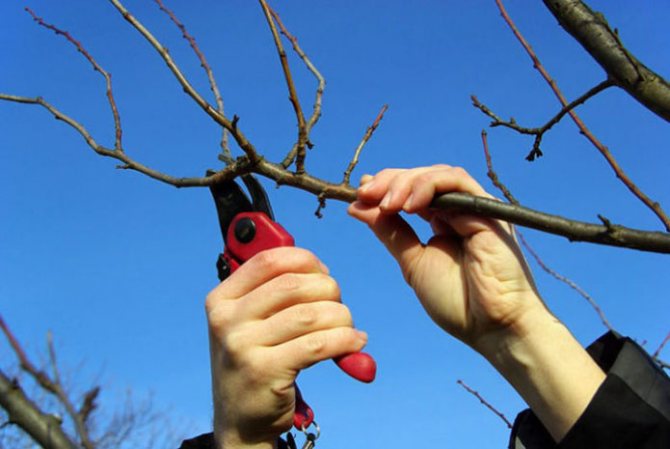

If the garden is young, one pruner is enough for it
For pruning plums, you need high-quality and well-sharpened tools:
- Secateurs for branches up to 25 mm thick. The bypass model is good for live branches, the anvil model is good for dried ones.
- Lopper for branches up to 50 mm thick in hard-to-reach places. Long handles will allow you to penetrate into the thickened crown.
- Small and large garden saw (hacksaw) for branches thicker than 50 mm (dead and dry)
- Garden knife for burrs and irregularities.
Cuts and cuts need to be processed with garden pitch - prepare it in advance.
Pruning old plums
With normal care, the plum can bear fruit for 15 years or more, but as soon as you find growth diminishing and a decrease in yield, carry out a rejuvenating pruning of the tree: shorten the conductor and cut off the skeletal branches in the upper part of the crown. This technique is used so that the sun's rays and air can penetrate into the very depths of the crown. Then remove the branches that have appeared in the last 3-4 years, cut out unnecessary tops, shoots and branches directed into the depth of the crown, intertwined with each other, hanging from the trunk or from the branches of the lower tier. Dry, broken branches and shoots infected with diseases or pests should also be removed. Clean the places of cuts and cuts with a knife and treat with garden varnish or oil paint on linseed oil.
If the old tree has never been pruned, you will have to divide the procedure into three steps: you can only remove a third of the old branches in one season.
What care to provide for trimmed wood
Pruning is stress for the tree, you need to help to endure the consequences of the procedure with minimal losses:
- Clean the cut with a knife and generously lubricate with garden varnish.
- Feed the plum with fertilizer, mulch the trunk circle.
The trunk circle at the plum must be at least 2 meters in diameter.
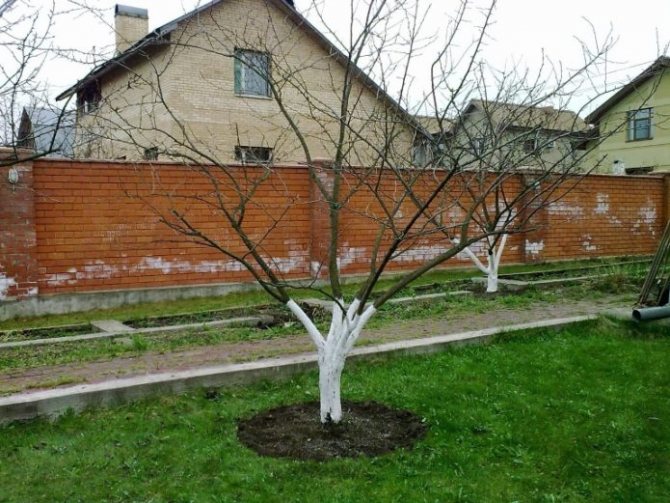

The pruning process should be carried out in good weather, when frosts, stormy winds, heavy showers are not expected.
After pruning, you can feed the plum with a solution of minerals:
- 35 liters of water;
- superphosphates (3 tbsp. l for every 10 liters of water);
- sulfurous or potassium chloride (2 tablespoons for every 10 liters of water).
Water the tree with this mixture, mulch the circle with dry earth, straw or wood shavings, loosen it by digging in the mulch.
Pruning plums in the fall is needed to increase yields and easy wintering. It is important to carry out work at least a month before the onset of constant frosts, so that the tree has time to recover after the procedure. Without pruning in the fall, you cannot get a healthy, strong plum with stable fruiting.
Tips and secrets from experienced gardeners
A process like pruning cherries can be tricky for beginners. However, it is worth remembering that the cultivation of this plant in the fall will only bring him good and help to endure the winter.
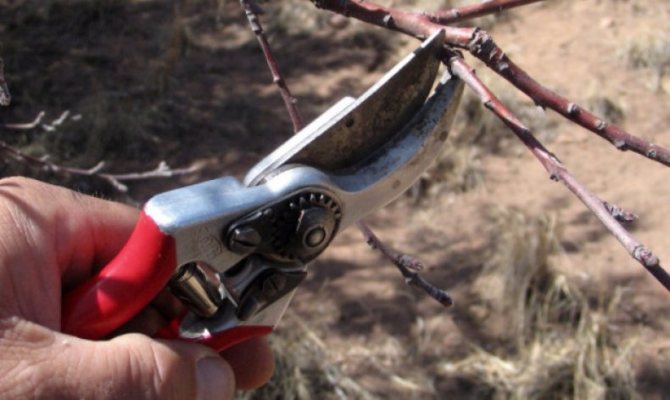

Experienced gardeners give these tips:
- It is imperative to carry out circumcision only before the onset of frost.
- Remember the difference between cherries and other fruit trees: the buds of the tree are not located along the entire length, but at the ends - therefore, when sanitizing, they must either be completely removed or thinned out, leaving 2-3 buds on each branch. In this case, the yield will not decrease.
- To completely rejuvenate cherries, you need a saw.
- It is advisable to prune the tree so that all annual shoots are about the same length - 30 cm. In this case, the branches will not be exposed.
- Do not forget to remove the annual root overgrowth of cherries - such branches significantly reduce the yield.
- The most optimal height for cherries will be a height of up to 3 meters - this should be taken into account when cultivating.
- The pruning process must necessarily be annual - the cherry thickens very quickly and slows down the growth of fruiting branches.
- You cannot cut all branches in a row, you should distinguish between annual and bouquet branches.
Until now, opinions differ as to whether it is possible to prune cherries in the fall, or should it be done only in the spring. However, the experience of competent gardeners and the results of research have proven that the cultivation process in the autumn is the best way to help the tree prepare for the cold.
It is very important to remember that the purpose of pruning is not to change the plant beyond recognition, but to correct and sanitize, which improves the future harvest and provides prevention against various diseases. Correct adherence to pruning technique will ensure healthy tree care and a good harvest in the coming season.
Pruning pear
When to prune a pear
Newbies in horticulture believe that pruning a pear is no different from pruning an apple tree, but this is not entirely true. We will tell you about when and how to cut the pear, and you yourself do a comparative analysis. A pear, like an apple tree, is not recommended to be pruned every year.
Autumn sanitary pruning of pears is permissible as long as the outside temperature is above zero, but if frosts suddenly hit, then pruning should be transferred to spring - in cold weather trees cannot be pruned, since the wounds remaining after pruning not only do not heal, but also lead to freezing of the branches, which is why they die. It is best to prune the pear in the spring when the air temperature warms up to 8 ºC.
However, if it becomes necessary to do this in the fall, then pruning in September, but no later than that, will be quite acceptable. The most convenient crown shape for harvesting is pyramidal, and this must be taken into account when formative pruning of the pear.
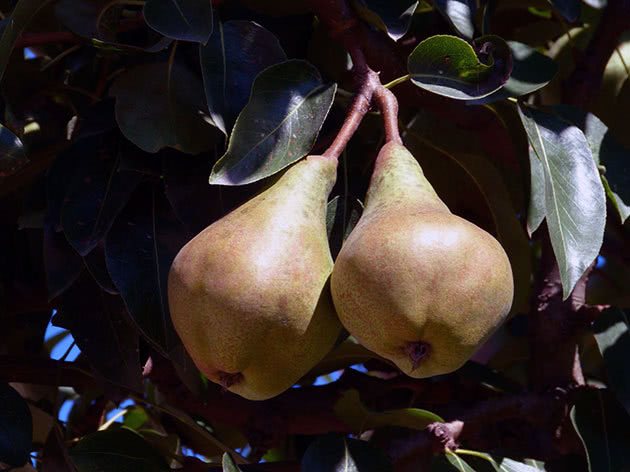

In the photo: Pears on the tree
Pruning pears in autumn
They begin to form the crown of pear trees already in the first year of life: it is very important to determine the skeletal branches at once, so that in the future the crown develops correctly and symmetrically. Annual seedlings are cut at a height of 40-50 cm from the ground. In two-year-old trees that have already acquired 6-8 lateral branches, choose 3-4 of them as skeletal ones and prune them at the same level. The guide is pruned 20 cm higher than the skeletal branches.
Pruning of older trees in autumn pursues mainly sanitary purposes: the removal of branches thickening the crown, diseased and damaged branches during the fruiting period. It also does not hurt to shorten one-year shoots and even the top of the head by a third of the length, if the pear stretches up too much - this will strengthen the tree, strengthen its branching and serve as an impetus for the enhanced development of the buds. However, try not to disturb the pyramidal shape of the crown during pruning. After completing the procedure, treat the cuts and damage to the bark with garden varnish: on old dry branches immediately, and on young, green branches only a day later.
Proper planting and caring for a pear in the garden
To make pruning for the rejuvenation of an old pear, you need to start by shortening its top, but if you have been conscientiously pruning the tree from year to year, and the crown height corresponds to the optimal indicators, then proceed to thinning it: remove dry, old, non-fruiting branches, cut out the shoots growing at an acute angle or parallel to the trunk, and shorten the remaining shoots by a quarter of the length. Treat all sections with garden varnish or paint on linseed oil.
In fairness, it should be said that rejuvenating pruning of old pear branches is less painful for the plant in spring, when the air temperature reaches 5 ºC, but the buds have not yet woken up.
- Blackberries: planting and care, growing
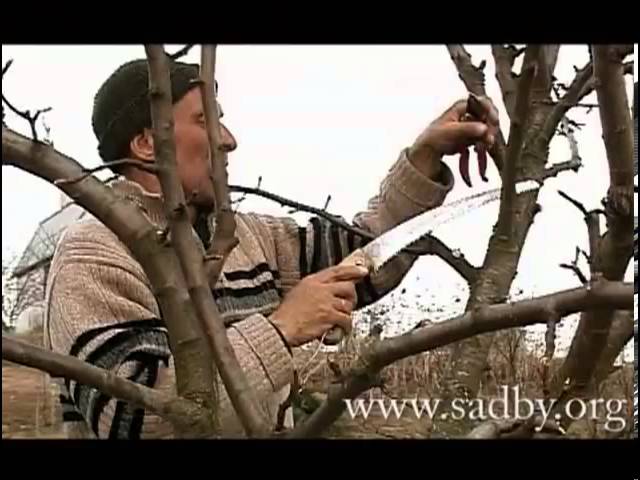

Pruning apricot
When to prune an apricot
Apricots are pruned in spring, summer and autumn, and in spring, pruning is carried out thoroughly - both formative and sanitary, and, if necessary, rejuvenating. In summer, pruning is done only when there is a danger that the branches may break under the weight of the fruit. The task of the fall sanitary pruning is to prepare the apricot for wintering.
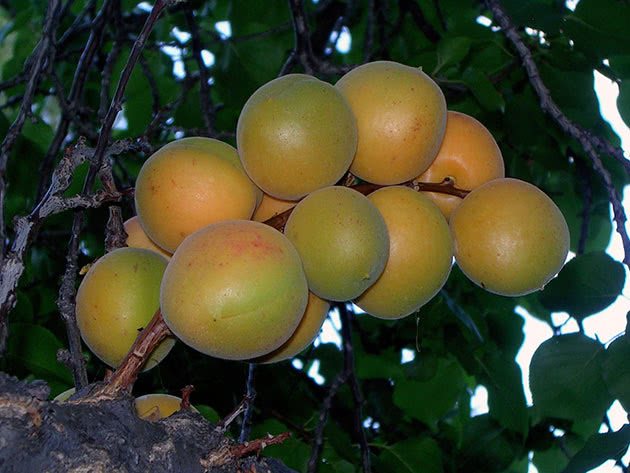

Photo: Rich harvest of apricots
Pruning apricot in autumn
Before you start pruning, you need to determine what type of crown you want to form in the tree - tiered or non-tiered. If you have limited space, it may make sense to cup the crown, which involves cutting the branches by about half. But no matter what shape of the crown you formed, in the fall it is necessary to remove all diseased, dry and broken branches, thin out the crown by removing the shoots and branches growing inward - sanitary pruning of the apricot must be done in the fall. However, it should be borne in mind that the apricot culture is thermophilic, so be careful, try not to make deep cuts on it, and if you still hurt the tree, treat the wound with copper sulfate and cover it with garden varnish so that there is no gum leakage.
Proper planting and care of apricot in the garden
Regulating pruning of plums for fruiting: dazzle, pinching, kerbovka
This type of pruning keeps the crown tidy and balances the growth and fruiting of the tree. That is, growth and flower buds, as well as young shoots are distributed evenly along the entire perimeter of the crown.
Regulatory pruning of the crown is carried out in order to lighten the crown and preserve its specified parameters, it is applied in relation to the entire tree, and not to its individual parts.
This pruning is carried out in the summer and includes several types.
- Blinding buds (most often used for young trees) - removing unwanted buds. They are cut out at the base, grabbing part of the wood.
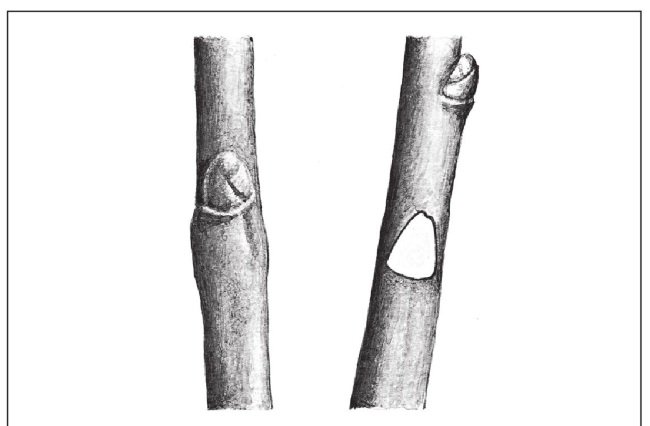

The buds are cut at the base, grabbing a piece of wood
- Pulling out of shoots, applied to growth-tops and fattening branches. The shoot is broken off by hand at the base. The cut is acceptable for mature trees, where the clarification of the buds is quite labor intensive.
- Pinching - pinching the top of a part of a young shoot (performed without tools). To do this, count 5 buds (branch length up to 20 cm) on a young growth and pinch it with your fingers. Pinching is carried out on trees at any age.
- Kerbovka - a longitudinal or cruciform cut above the kidney, stimulating its development. The method is applicable to young trees.
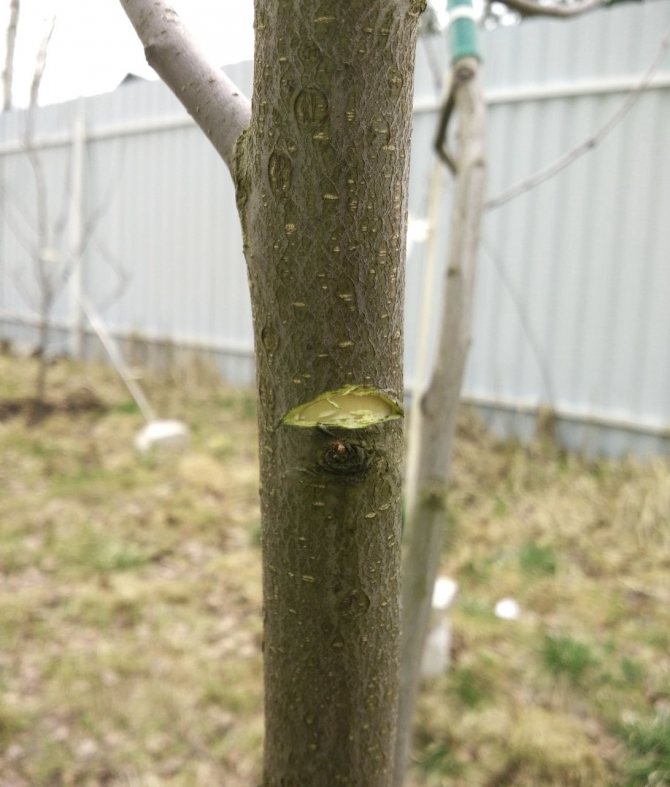

Kerbovka is more commonly used for regulating pruning of young trees.
Regulatory pruning helps to form the crown in summer and better prepare young shoots for winter.
Video: ways to lighten the crown of fruit trees
How to prune a 2 year old plum sapling the next season after planting
Plum at different ages has its own specifics of pruning: young trees do not need shaping, and old trees need rejuvenation - this is shaping and sanitary thinning at the same time. Experienced gardeners say that it is better not to touch plum saplings immediately after planting. If the plum is planted on the site in the spring, then only in the summer, after the young tree grows shoots, the intervention of the pruner will be required.
A plum seedling is pruned in the following summer:
- after landing, the central conductor is trimmed to a height of 0.8–1 m;
- leave a bare stem nd to a height of 30 cm (extra shoots are removed);
- choose 2–4 strong skeletal branches spaced evenly from each other (at a distance of about 10 cm), the rest are removed;
- the selected skeletal shoots are shortened by 5–10 cm to stimulate annual growth.
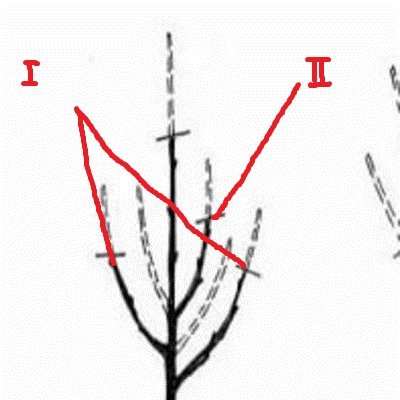

Formation of the first (and 1 shoot of the future second tier) two-year-old plum when planting
In plum saplings with weak shoots in the first year, the shoots on the trunk are not cut out, but pinched, which contributes to the development of shoots for the first tier.
As a rule, at this age, other manipulations with the pruning shears are not required. By autumn, the plum seedling will have 4–6 strong shoots. After pruning in the summer, it is recommended to feed and water the tree.
Seasonal sanitary pruning, which will also help clean up a neglected tree
This type of pruning is carried out annually, starting from the 2-3rd year of growth of the plum. With this procedure, do the following:
- broken, shriveled, damaged branches are removed;
- cut out growing crowns and thickening shoots;
- closely growing, rubbing against each other and thin weak processes are also removed.
Sanitary pruning is done regularly in early spring. But there is also a possibility that the procedure will need to be repeated both in summer and autumn.
Apple tree pruning
When to prune an apple tree
Apple trees are pruned in spring, in rare cases in summer, when ripening fruits in a dense crown do not have enough light, as well as in autumn. However, if in the spring before the start of sap flow with the help of a pruner, the consequences of winter are eliminated - the frozen ends of the branches are removed, while forming the crown of the tree, then pruning in November is carried out mainly for the purpose of reorganizing the crown. The procedure is started after all the foliage has fallen from the trees. Pruning of a columnar apple is carried out either at the beginning of summer or before winter.
Proper planting and caring for an apple tree in the garden
Pruning apple trees in autumn
In autumn, pruning of old branches, as well as rotten, broken, spoiled branches, is carried out. Since the tree is dormant, pruning is stress-free for the tree. How to prune an apple tree in the fall? According to this roughly the plan:
- First, cut off large broken or dried out branches;
- cut out the weakest branches that grow too close to each other;
- trim branches that grow at an acute angle;
- cover all sections with garden varnish or paint on drying oil: wounds on dry branches are treated immediately, and on young ones - only after a day;
- burn all the cut branches.
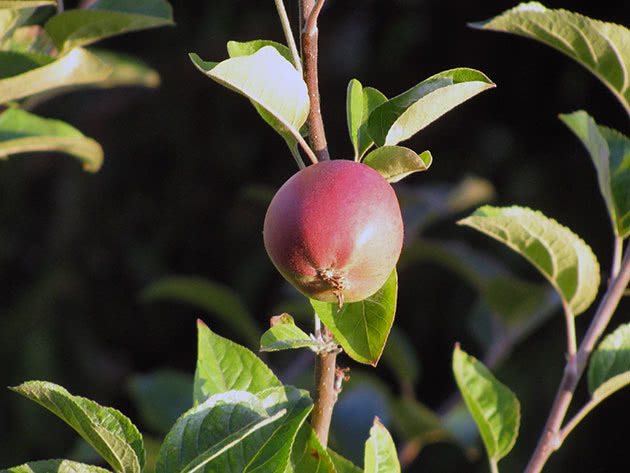

In the photo: Growing an apple tree in the garden
Young apple trees do a weak pruning with pruning shears - they shorten the growth of the current year by a quarter of the length. After that, the growing apple trees, unless they grow in height too quickly, are not pruned for three to five years, removing only dry and broken branches if necessary. Five to six-year-old apple trees need to be pruned at medium intensity: strong branches are pruned by a third. Strong pruning is used in cases of thickening of the crown: for its thinning, the branches are shortened by half.
Rejuvenating pruning of old apple trees is carried out in three stages: in one year, about a third of the old branches are cut, the next third of the old branches are cut out after a year, and the last third after another year. The pruner will not take strong adult branches, you will have to wield a saw. All tools you will use to prune branches must be sharpened and thoroughly sanitized.
Diseases and pests of apple trees - control and prevention
Pruning columnar apple trees
As for the columnar apple trees, you should know that the more you cut, the more actively what you left behind grows. If you cut more than half of the branch, then the remaining 3-4 buds will give powerful shoots next year. If you cut less than half of a branch, the remaining 5-7 buds will produce 5-7 medium shoots.
The central conductor of the column must not be cut, otherwise the crown will branch out. Forming the crown in a columnar manner, in the year of planting, the crown shoot of the seedling is tied to a support, and fruit links are formed from the lateral shoots, and if they are too powerful, then they are cut into a ring so that they do not retard the growth of the conductor, and wait for new shoots to grow, from which can form the skeleton of the crown.
Planting and caring for columnar apple trees in the garden
Cherry pruning scheme in autumn

General scheme of autumn pruning of cherries
The procedure is carried out according to a certain scheme: with the help of a secateurs, the most overgrown shoots are removed, which impede the development of the rest, the main branches in this case are not affected.
It must be remembered that each cut is essentially a wound to the tree, so the removal process should be taken with extreme caution. It is not necessary to get rid of all the branches that form an acute angle in relation to the trunk.
Slices are to be treated with garden varnish to speed up healing. The sooner the tree recovers, the better it will prepare for winter.
Gardeners recommend:
- remove shoots that are closer to the crown and grow downward or into the crown;
- to be guided by the situation: sometimes it is more expedient to delete one large branch than several small ones;
- do not be too zealous with cutting off small shoots - this negatively affects the growth of the plant;
- do not remove horizontally growing branches - as a rule, they give the most bountiful harvest.
Thus, the pruning scheme is quite simple - just remember a few simple rules. All removed parts of the plant must be very quickly removed from the site and burned to prevent the spread of diseases and pests.
Scheme of rejuvenating pruning of old wood with height limitation
By rejuvenating an old plum tree, you will not only prolong its life, but you will also enjoy fruiting even after 10-12 years from the moment of planting. This procedure activates the growth of the tree and stimulates the emergence of young shoots, allows physiological balance in the crown of the tree. The event is important not only for overgrown trees. When the annual growth of new shoots slows down (this can sometimes happen as early as 6-7 years), and the yield decreases, or the tree is severely damaged by hail or frost. Rejuvenating pruning of this fruit crop may be required in 10-15 years (depending on the variety and the strength of the tree's growth). The event takes place as follows:
- the stem is shortened to a height of 2 m;
- eliminate dry, sick, shoots going inside to the central conductor (sanitary pruning);
- then thinning is carried out: three main skeletal branches are selected, the rest are cut "on a ring";
- on the remaining shoots, in total, up to 30% of last year's growth is removed: 25–30 cm are cut off (pruning "to the bud") - the upper branches are cut over the lateral ones growing outward;
- cut root growth.
Shoots that form at the base of the stem are quite common on the plum. This is due to the fact that plum is a self-rooted fruit crop. Root shoots grow especially actively in the 4-6th year after planting - these shoots should be completely cut out at the base, including during rejuvenating pruning.
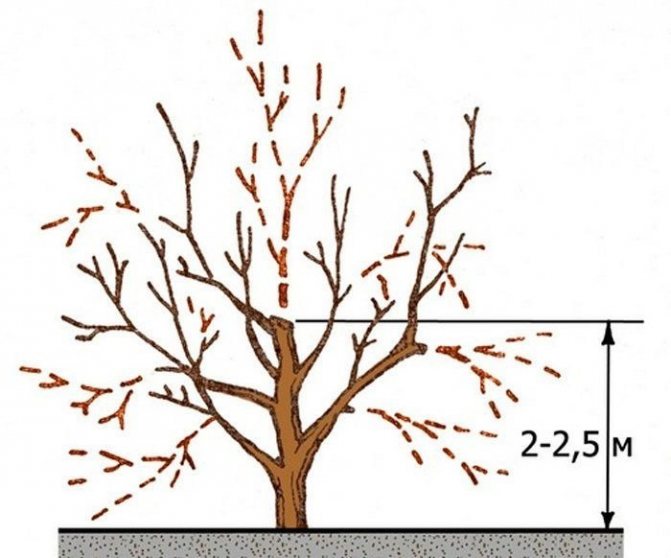

Plums over 10-15 years old need rejuvenation
Rejuvenation of the main branches and fruit wood leads to the fact that a large number of new growths are formed in all parts of the crown. These increments require a certain amount of pruning, which should be done or already in the summer.
Basic ways
Depending on their tasks, gardeners prefer one of two types of procedure:
- Thinning... Most often used in the cultivation of shrubby cherries that grow in breadth. This is the best option for pruning cherries in the fall to prevent thickening, which negatively affects yields. In this case, branches and shoots are completely removed.
- Shortening... This procedure accelerates the swelling of the buds and stimulates the growth of shoots. A certain part of the top or branch of the tree is removed.
Learning to saw and cut correctly
Proper care of stone fruits, including plums, consists in adhering to agricultural technology.Fruit trees need watering, regular nutrition, and certainly proper pruning - these are the determining factors for the effective cultivation of fruit-bearing horticultural crops. Plum grows in the form of a bush - up to 2 m and in the form of a tall tree with a narrow pyramidal crown (tree height up to 7-10 m). Getting started pruning a plum, it is important to understand that basically this tree bears fruit on spur shoots located in the lower part of the trunk and on bouquet branches of the second year (when forming a tree-like crown type) - both the first and the second grows annually by 5-10 cm , fruit shoots live up to 4–5 years, in which case the harvest is concentrated inside the crown.
In the axils of the leaves, there are 2–4 growth buds, on spurs and bouquet branches there are usually 1–2 growth buds (leaves or shoot) and from one to three flower buds - our future harvest.
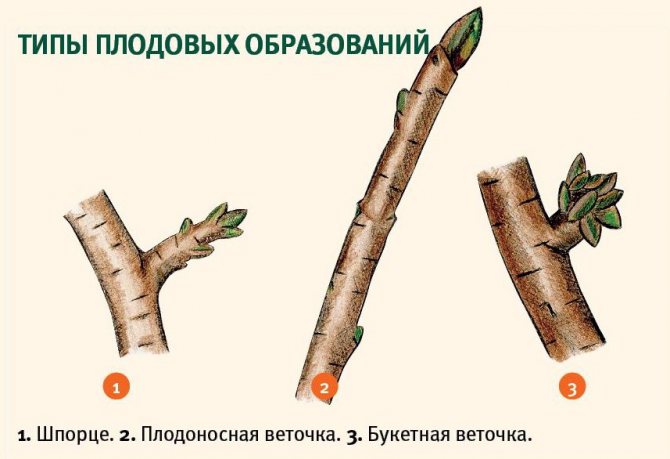

Types of fruiting plum formations
Thus, pruning a fruiting plum is to exclude a weakening of the annual growth (on which the main crop will be formed) - branches up to 40 cm do not need pruning, and shoots longer than 55-60 cm must be shortened annually by 10-15 cm. If this is not done, the fruiting branches become bare and sagging, in subsequent years they give less and less ovaries.
Plum growth: first summer - growth, second summer - annual wood blooms and at the same time sprouts with fruit twigs (spurs). Further, both annual shoots and spurs bloom: the tree is all in flowers, to the very tips of the branches. Many varieties of plums do not bloom on annual shoots, forming different fruit branches below. The fruits of these crops can branch and work for 5-6 years, but due to fungal diseases they usually die in the 3-4th year.
N. Kurdyumov
Pruning plums implies thinning - controlling young growth and shortening old, fruiting shoots to the length required by the type of formation, or up to 50-60 cm. But it is important to remember that some varieties do not give abundant growth and do not require annual intervention of the gardener, such cultivars need to be formed every second growing season.
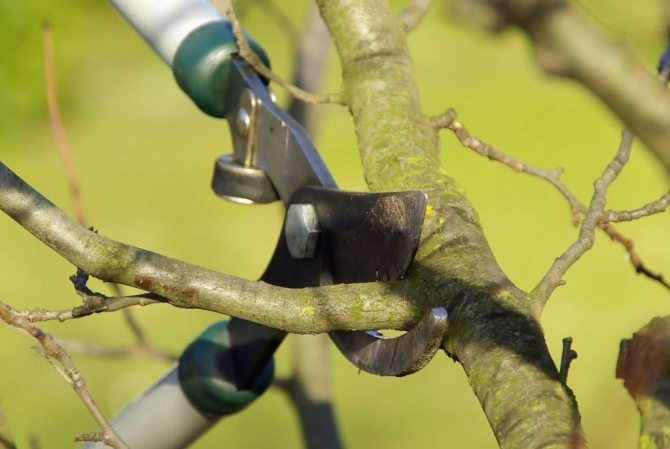

Pruning plums with pruning shears
What features of plum fruiting are taken into account when pruning branches
The type of fruiting determines the frequency of the gardener's intervention with the pruner. Plums are divided into three types depending on the fruiting.
- Varieties that bear fruit on two-year spurs and bouquet twigs - Hungarian, Peach and others - here requires careful cutting of old and thickening shoots.
- Plums, which have a mixed type of fruiting, - there are ovaries both on annual growths and on two-year lateral spurs, this is typical of the varieties Volzhskaya krasavitsa, Pamyat Timiryazeva, Mirnaya, Tulskaya black, etc. - sanitary cutting is carried out annually, regulating or shaping necessary (every 2-3 years 4 years after planting).
- Exclusively on last year's increments, the Ussuri, Chinese, American plums give a harvest - the bulk of the fruits is formed along the entire length of the shoots - by all means thinning, adjusting and shaping as needed.
The best cut is no need to cut. Formation is needed so that you do not have to cut. The earlier the impact, the stronger the effect with less effort. In time - this is when it is already visible, but has not yet influenced.
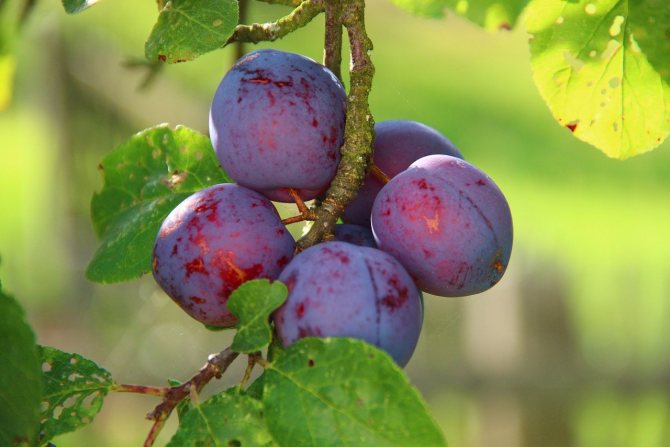

Depending on the type of fruiting of the plum, the method of pruning the tree is selected
When and why the plum is cut in spring, summer and autumn
Spring is the ideal time for pruning and shaping the crown of the plum, spring cuts are better tightened, and during the growing season the plant rehabilitates better after "surgical" intervention. But experienced gardeners claim that this stone fruit crop can be pruned at any time of the year.


Experts advise pruning plums at any time of the year, and shaping in spring
This procedure should be resorted to only with the onset of stable warming - that is, the gardener must make sure that the threat of frost has passed. Experts recommend carrying out any activities with a pruner in dry, calm weather. It is believed that you should not start pruning plums on the eve of frost and frost.
First, pruning is organized on mature trees, and then on young ones.
In central Russia, in the Volga and Chernozem regions, it is quite possible to carry out spring pruning of plums - starting from the end of March, and autumn - in the 2-3rd decade of October, the weather is quite favorable for this. In the southern regions (Crimea, Caucasus, Krasnodar Territory, Kuban), most often pruning of plum trees is carried out throughout the season: in the spring (1-3rd decade of March) - regulation and shaping, in the fall (in October - November), sanitary thinning is usually required ... In the northern regions of our country (Siberia, the Urals, the Far East), plums are cut only in spring - weather conditions allow the procedure to be carried out in April. Summer pruning is possible in any climatic zone.
Video: spring pruning and shaping the crown of a plum
In autumn, as at any other time of the year, mature trees can be cut dry, broken and thickening branches.
After the autumn pruning of plums, it is advisable to cover the places of the cuts with garden varnish or paint on natural linseed oil, which will contribute to their early healing.
Compared to spring pruning, pruning fruit trees in autumn should be more gentle and careful so as not to weaken the tree.
Video: autumn pruning of plum crown
In summer, pruning shears may be needed to thin out the crown - the plum very quickly builds up its "green" mass, and to regulate fruiting.
Video: how you can cut a plum in the summer
Some experts believe that pruning plum trees in the summer is necessary in order to stimulate the growth of annual growth - this is especially true for varieties that bear fruit on two-year-old shoots. In this case, pruning is carried out in July (pinching), or later, after picking up the fruits (it is more convenient to work this way) - in August, all the more the ripening plum crop is harvested at once, otherwise it all falls.
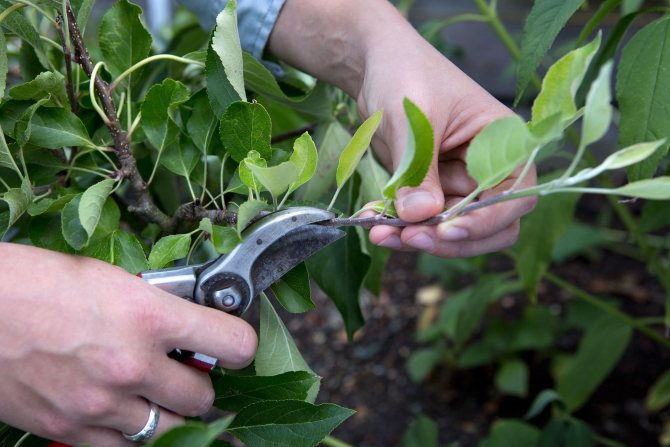

Plum pinching is a type of summer pruning
During the summer, you can cut off growing twigs with a diameter of no more than 2.5 cm without putty. It is also necessary to remove the root growth. To do this, root shoots are removed from the root collar.
It is believed that young plums should be pruned 3 weeks before active sap flow (approximately in the 2nd decade of March), older trees are pruned during March - April. In any case, the owner of the garden should be guided by the climatic conditions of the region and the weather in the coming season. Experienced gardeners recommend, in addition to spring and autumn pruning, resort to summer pruning: in summer, old, fruiting shoots (bare) are clearly visible - they can be removed. At the ends of last year's branches one can clearly see the juvenile grown "forks" - three shoots each, one of them can be cut off immediately (growing incorrectly or inward), the second can be pinched - it will give additional growth during the summer.
The formation of a seedling and the rejuvenation of an adult tree should be completed about a month before bud break. In the case of sanitization with the removal of sick, frozen and dry parts, there are no time limits. Non-leaf rods make it easier to determine which ones should be removed. When pruning, be sure to use a garden pitch.
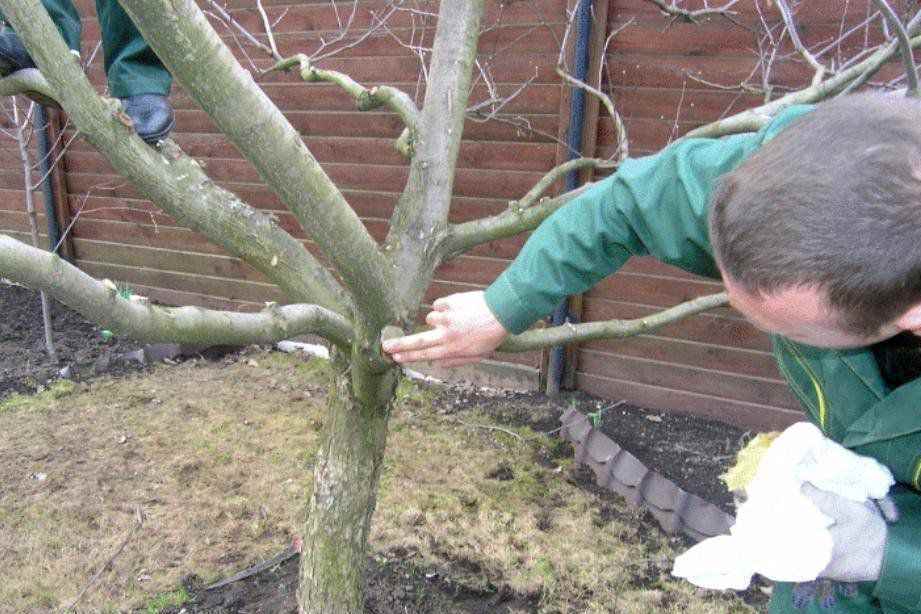

Garden var - the first assistant when pruning garden trees
The main goals and rules of pruning
Annual pruning of fruit trees:
- allows you to get a well-groomed tree;
- guarantees annual fruiting;
- increases the growth of "fruit" or young shoots;
- regulates fruiting;
- allows you to lighten the crown, get rid of unnecessary (old, crooked branches), thus stimulating air exchange and the permeability of light into the crown;
- helps to redirect nutrients to fruiting shoots and slow down the growth of unproductive shoots.
Correct pruning affects the regularity of fruiting, immunity and longevity of the tree.
Before pruning, it is necessary to prepare well-sharpened tools (garden knife, pruning shears), a ladder and gloves - the plum often has short spurs on the trunks and perennial shoots that can injure hands... And you will also need a garden pitch for putty slices.
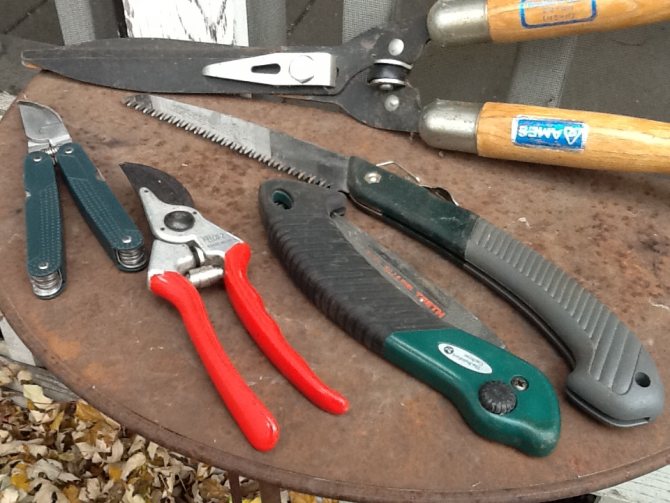

Plum pruning tools
Small branches are cut with a garden knife or pruner, and thick ones are cut with a hacksaw. Old thick branches, so as not to injure the tree, are first sawed off in the lower part, and then finally sawn off from above, "into a ring" without leaving the hemp.
Video: pruning technique - we form the crown of a plum
Why is pruning done?
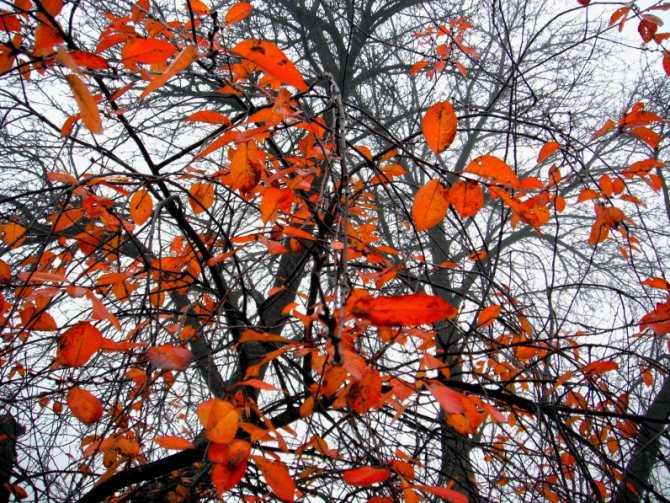

Uncut cherry
The assertion that cherries do not need special care is just a common myth. The lack of correction leads to the fact that the tree grows in all directions, and the yield decreases markedly. In addition, the dense crown creates excellent conditions for the development of diseases. If the trunk is infected with a fungal or bacterial infection, the cherry risks dying altogether.
Pruning branches makes it possible to:
- create favorable conditions for the rejuvenation and restoration of cherries;
- prevent plant depletion;
- positively influence growth and fruiting;
- correctly form the crown of the tree, which will allow the sun's rays to be distributed evenly;
- remove the affected branches in time, stopping the spread of the infection.
Pruning is not particularly difficult even for novice gardeners with a lack of experience - they can do this work efficiently and quickly.
Popular mistakes when carrying out the pruning procedure in the spring
Novice gardeners, due to lack of experience during pruning, often harm the fruit tree. Here are some of their mistakes:
- Rejuvenating pruning of old wood is carried out in one go.
- When pruning a young tree, a cut is made on the upper bud.
- In regions with harsh long winters, the plum is pruned in the fall.
- Because of pity for the plant, many unnecessary branches are left in the crown.
Spending a little time on pruning, the gardener will not only improve the yield of his favorite tree, but also ennoble the site, since a compact tree looks much neater than an unkempt tree.
Video: how to fix an incorrectly cut plum branch
Trimming a columnar plum
The columnar plum has a compact crown. Fruits on such a tree do not grow on spreading branches, but along the trunk, so the side shoots are useless. They are pruned annually.
In this case, it is important to completely preserve the central conductor of the tree, it is not touched at all. If the top of the main shoot freezes, then additional shoots (two or three) will grow in this place over time. In this case, one, the most developed, is left, and the rest are removed.
To get a good harvest of fruits, you need not only to properly cut the plum, but also to properly care for the tree throughout the year. Read about the intricacies of caring for this plant in the article Growing plums in the garden - all about planting, watering, feeding and processing.
General principles of pruning
The entire pruning process can be roughly divided into two steps:
- pruning (shortening) is the removal of the upper part of the shoots, branches. The main task is to strengthen the main branches, cause the active development of the buds located below the pruning site, and accelerate the growth of young shoots. On cherries, branches longer than 40 cm are usually shortened. Pruning can be weak (cut to 1/4 of the annual growth), moderate (up to 1/3 of the growth) or strong (half of the growth);
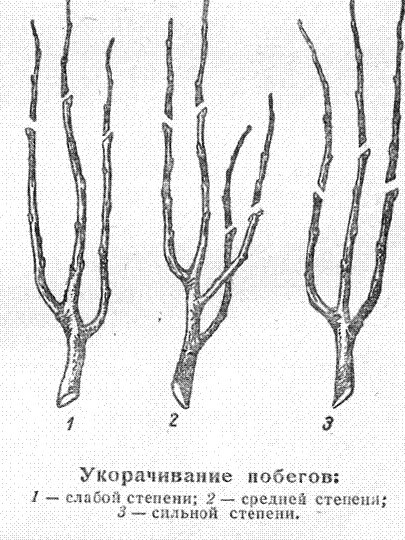

Shoot shortening can be of three different types: weak, moderate and strong
- cutting (thinning) - removal of a branch or shoot entirely, to the base. This type of pruning is designed to improve the access of the main branches to light and air, which will have a good effect on the development of the fruit.
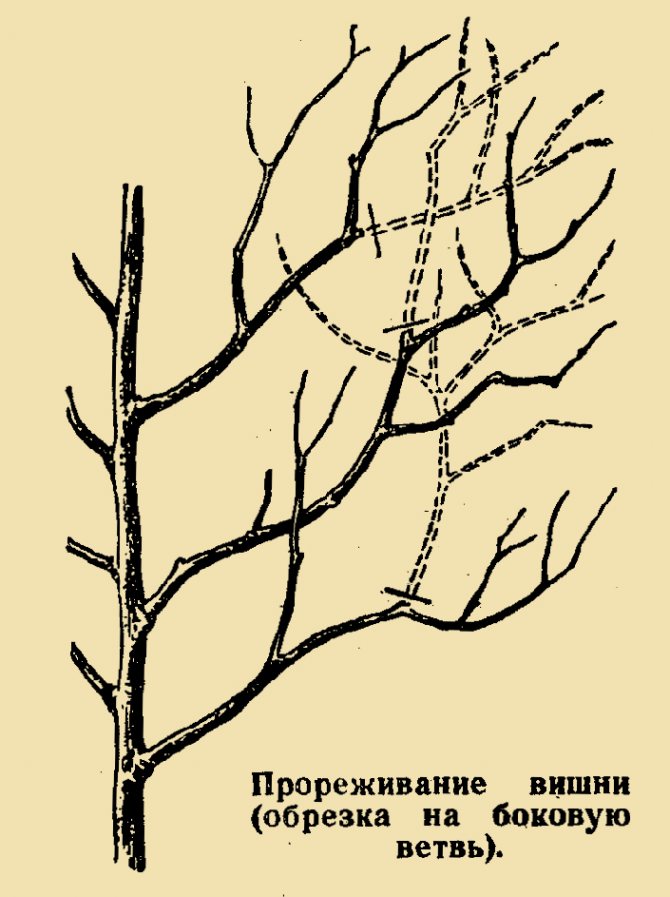

You can clearly see how thinning affects the density and shape of the crown.
When pruning cherries, thinning is most often resorted to. This is due to the fact that its buds are located closer to the ends of the branches, so shortening will be less effective for improving fruiting.
To learn how to properly prune cherries, you also need to be able to determine the type of branch:
- vegetative branches. They are also called growth. These are the branches from which the rest of the branches and shoots grow in the future;
- bouquet twigs. They are found mainly in tree cherries. These are short (up to 3 cm) branches on which there are many buds. The main fruiting is carried out on them;
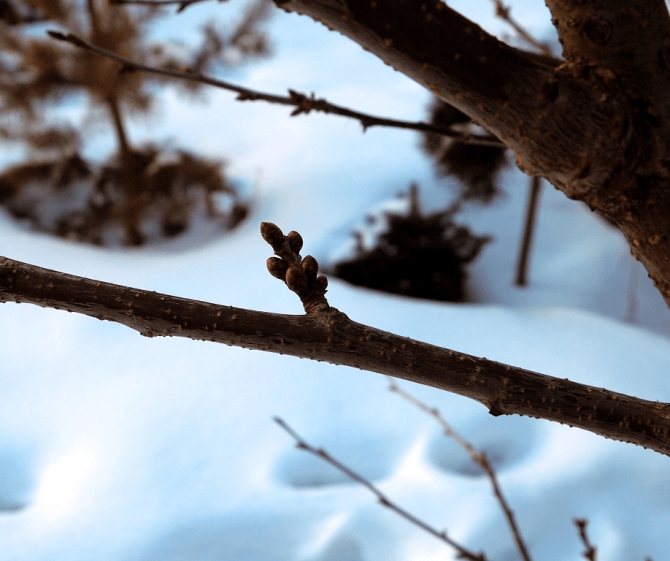

Bouquet branches are easy to identify - they are small in length and a large number of buds
- growth branches. These are small and thin branches that emerge from the upper buds every year. It is not difficult to distinguish them - the topmost and youngest branches are growths. Most cherries bear fruit on these shoots.
Slice methods
When pruning cherries, the following cuts are most often used:
- to lateral bifurcation. The main branch (thicker) is cut down to a strong lateral branch;
- shortening by translation. If a branch bifurcates, it can be shortened by removing one of the shoots up to the fork. The choice of shoot depends on the situation, but when pruning cherries, external branching is most often left;
- on the ring. In this case, the branch growing from the conductor is cut down to the very base.
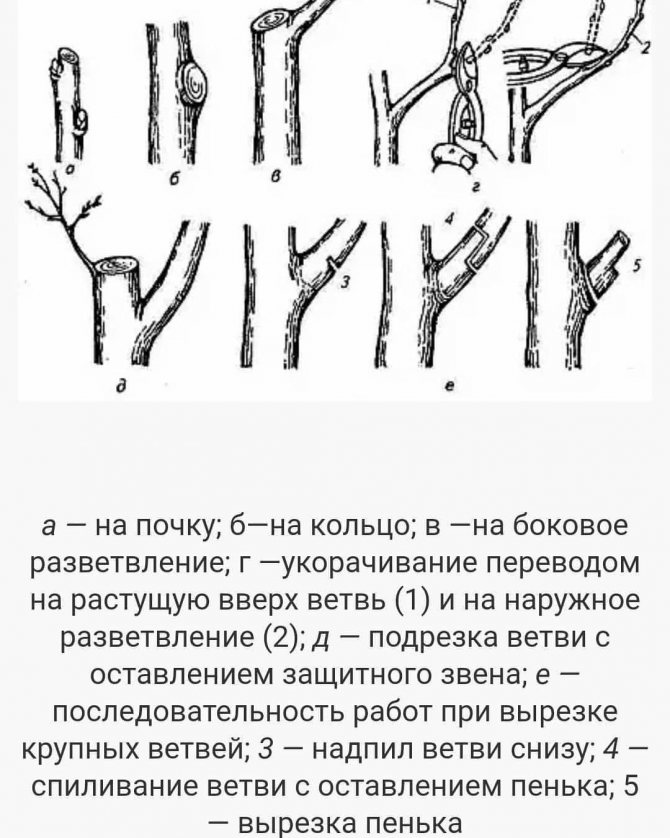

The diagram clearly shows how this or that slice is performed
Many gardeners know that most plants should be cut with chemicals such as ground coal or garden pitch to protect the branch from infections and improve healing, but this does not apply to cherries. Treating cut branches of a cherry tree or bush will make recovery more difficult.
When to prune cherries
Cherries (of any variety and type) are pruned every year. A fresh seedling, planted in March-April before the buds swell, is pruned immediately after planting to form a crown.
Any tree or bush is pruned in early spring, even before the buds swell. At this time, active sap flow has not yet begun, and the plant will tolerate the removal and shortening of branches well. If you did not have time to cut the cherries in March, you should not cut off the branches after the buds have swollen - there is a high probability that they will dry out to the very base.
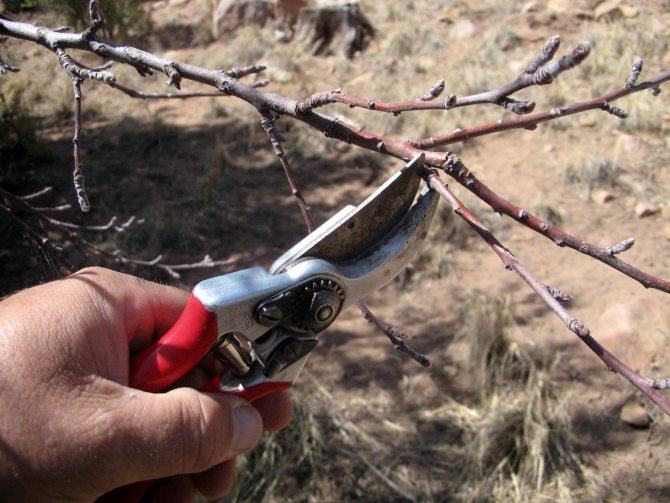

Cherry pruning should be done before budding.
In summer, after fruiting, only mature, well-developed trees can be pruned. Autumn pruning is, as a rule, sanitary - before winter, weak, drying out, diseased branches are removed from the cherry in order to facilitate the wintering of the plant.
This sanitary pruning can be done any month if necessary. If you notice a diseased or dying branch, remove it immediately. In autumn, you should carefully examine the tree for damaged or weak branches and cut them out, if any.
Purpose and timing of haircuts
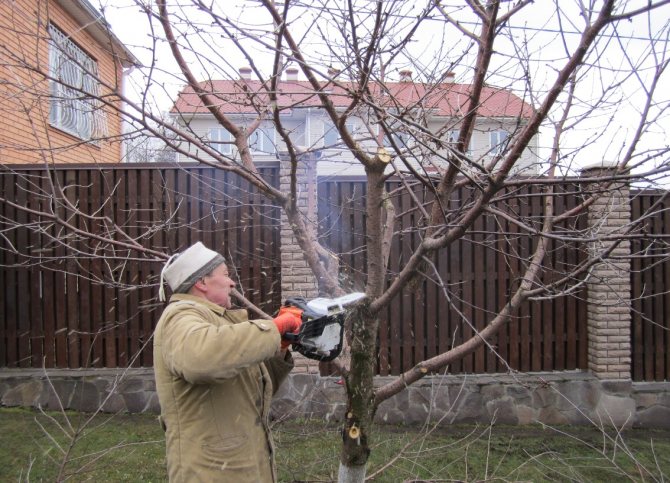

Pruning can affect the formation of fruits, the very development of culture. It is necessary to adhere to certain rules so as not to deprive a healthy plant of strength, not to cut off the branches that bear fruit. Pruning plums for preventive purposes is carried out in the fall, the following points are taken into account:
- to establish the direction of growing branches;
- for sanitary purposes (dead, diseased branches are removed);
- to form a crown and if this procedure was not carried out in the spring;
- in order to prepare for winter;
- if it is necessary to shorten growing shoots that started their growth late
Autumn is the best time to prepare for hibernation. Experienced gardeners note that after the formation in the autumn, the branches do not break off due to the severity of the snow masses, they can withstand a strong breath of wind.
On a note!
Pruning reduces the number of kidneys that consume micronutrients. This leads to an acceleration of the ripening of the crop.
The annual growth for the next calendar period increases, the airing of the crown is stimulated, which leads to a good harvest. Pruning is carried out several weeks before frost, so as not to cause freezing of the wood at the cut points.
Pruning fruit trees
Pruning is the complete or partial removal of shoots and branches, a way of caring for ornamental and fruit shrubs and trees, which serves to regulate their development, growth and fruiting. In addition to the formative function, pruning also performs a sanitary one - it thinns the crown and frees a tree or bush from branches that endanger the health of the plant and endanger its longevity. And if the tree has entered old age, then rejuvenating pruning done in time will give it new strength and prolong the years, practically without reducing the quantitative and qualitative indicators of the harvest.
Pruning of trees is done both in spring and autumn, in some cases trees are pruned even in summer. Let's make a reservation right away: autumn pruning of trees is permissible only in areas with mild, cold winters, and in the northern regions this procedure is best carried out in the spring, since frosts that come soon after autumn pruning lead to freezing of the bark at the cut sites and dry out the wood, which, as a rule, leads to death of plants. There are types of fruit trees that are pruned every year, or even twice a year, and there are those that do not need annual pruning.
Each agricultural technique has its own rules, and tree pruning is no exception. When to prune trees of certain types and how pruning of fruit trees is carried out in autumn are the topics of our conversation.
- Seedling strawberries in 2019 at home from seeds


Tools for work
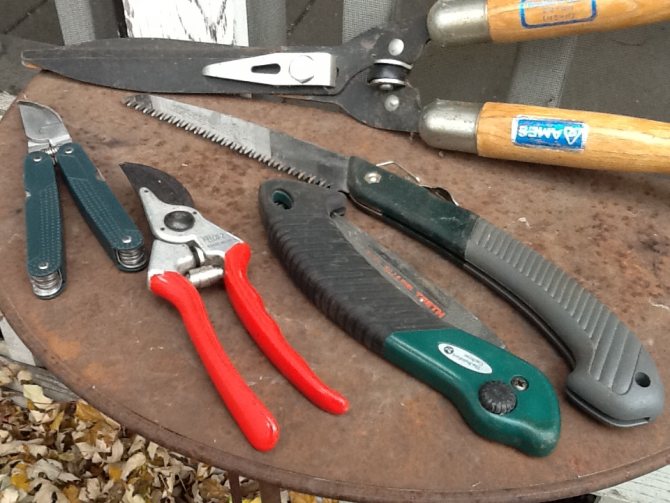

Required trimming tools
To carry out correct pruning, you need to arm yourself:
- pruning shears or garden knife, allowing you to work with small branches;
- a saw for removing large branches;
- a stepladder or ladder.
In addition, you will need a garden pitch for covering large sections. To avoid the penetration of infection, pruning is performed only with a well-disinfected instrument.
Do not use a dull knife or a rusty saw - this often causes irreparable damage to the tree.
Features of preparing plums for winter in different regions
It is necessary to prepare the plant for wintering as carefully as possible. In this case, the characteristics of the region in which the tree is grown is taken into account.
In the middle lane (Moscow region)
Crop care consists in carrying out stimulating watering, feeding, digging up the soil and pruning. Also during this period, the plant is fertilized.
In the Volga region
In preparation for wintering plums in this region, the gardener needs to perform a number of specific actions - dig up the soil, apply fertilizer, whitewash and prune. It is also recommended to carry out stimulating watering.
In the Urals
In this region, the climate is not harsh enough, but it is still recommended to carry out warming of young plums here, since this ensures the highest quality plant survival. Stimulating watering is carried out in early autumn. In the Urals, it is recommended to carry out partial pruning of the plant.
In Siberia
This region has a rather harsh climate. That is why it is necessary to insulate crops, regardless of how old they are. In order to recuperate, the tree needs feeding. It is carried out immediately after shedding the foliage.It is strictly forbidden to carry out abundant watering, as this can lead to freezing of the root system and the death of the plant.
Typical mistakes in plum care in autumn and preparation for winter
Many gardeners make gross mistakes when caring for plums in the fall.
For example, some of them do not remove foliage to warm the plant. But it is strictly forbidden to do this, since there can be a variety of diseases on the fallen leaves, which are actively developing after wintering.
Gardeners do not clean the plum boles... However, it is extremely necessary to remove moss, dead bark, lichens from them. If there are wounds, it is recommended to clean them. For processing with the aim of the fastest healing possible, garden var, copper sulfate, lime solution can be used.
Gardeners believe that in the autumn there is no need to protect plums from diseases and pests... On the contrary, plums need protection from aphids and caterpillars, which are classified as dangerous pests. For this purpose, it is recommended to use an onion-garlic solution. Take several glasses of onion skins. To them are added two large heads of garlic and laundry soap in the amount of one bar, which is pre-crushed on a grater.
All components must be thoroughly mixed and filled with 5 liters of boiling water. It is recommended to insist the remedy for several hours. After this time, the product is filtered using gauze. After the solution has cooled down, the plum is treated by spraying.
In the autumn period, it is necessary to ensure proper care of the plum in preparation for winter. For this purpose, the gardener is advised to perform certain actions. Their order is determined according to the region of cultivation.
The formation of a plum crown is not an easy and very important matter. If the tree is cut incorrectly, the harvest will be poor. To prevent this from happening, find out how and when to prune plums in the garden.
Pruning and shaping of plums is carried out to increase fruiting. The thickened crown has a negative effect on the condition of the plant. The tree becomes sensitive to cold weather, in winter it risks freezing out. Excessive branches create shade and thus prevent the fruit from forming properly.
Pruning of young plums is carried out for the first time at the time of planting a seedling, after which it is done regularly throughout the life of the plant. In this case, the crown is formed up to about 15 years, and then only dry and diseased branches are removed, young shoots are not touched. Then the tree bears fruit well even at an advanced age.
Technology
Most fruit trees are formed according to the principle of a tiered sparse crown. The experience of seasoned gardeners will tell you how to properly prune plums.
Skeletal branches begin to form in young plums of the first and second years after planting. To do this, remove unnecessary shoots and leave only those that are directed in different directions. Ideally, the branch above is 120 ° with the branch below. This ratio is observed for each shoot. Correct pruning allows light and warmth to reach any tier. The result is a crown that is easy to care for and harvest.
Of all the fruit species, plum is the only tree for which pruning can be done through shaping by a bush.
The method is relevant for small areas where there is no place to grow a large tree. Another option is decorative use, when hedges are formed from plums. Then she is cut at least twice. Summer pruning of plums can be done after the stems and leaves of the current year have grown. The second obligatory haircut is needed in the fall. In the summer, lonely shoots appear, which must be removed before winter.
When is the best time to prune a plum depends on what time of year it is planted.If the spring planting of the tree was successful, and it successfully took root, then the crown begins to form in the fall. Accordingly, the first pruning of plums in spring should be done after the autumn planting.
Recently, trees with a clod of earth are often planted. This is convenient because it can be done at any time of the year when weather and soil conditions permit. In this case, in the first year, all forces are directed to the survival of the plant, and pruning begins during the two-year growing season, that is, next year.
Crown formation lasts until the beginning of fruiting in the second, third year after planting. In the future, shortening and removal of thickened shoots are used.
Now let's tell you more about how to properly trim the plum.
General scheme
There are different ways to form a crown:
- «On the ring», when shoots of the second order are cut to the skeletal branch, and a cambial influx is formed.
- «On the kidney» - the shoot is shortened so as to direct the growth of the future shoot to the outer edge of the crown. Often, after such pruning, in addition to the necessary stems, tops are formed, there are especially many of them on the drain. These are overly thickened branches that can be removed at any time of the year. In this case, pruning the plum in summer will not hurt.
- The method that regulates the regrowth of young stems is called "transfer to lateral shoot»... This is done when you need a rejuvenating pruning of the old crown. Remove old, unpromising branches and those that are directed towards the trunk.
It is necessary to follow the rules of pruning constantly, since the plum is prone to intensive growth of the green mass. This property negatively affects fruiting.
Features when performing pruning of columnar varieties
A common mistake for beginners in horticulture is trying to prune a given variety of fruit trees, like other species. Not everyone knows that the peculiarity of a young seedling, which looks like a twig, persists throughout the life of the plant. The columnar shape is not subject to pruning rules for spreading fruit species.
On an upright stem, short branches are formed, 2-3 cm long. Flower buds and fruits are formed on them. You do not need to trim them. On the contrary, only those branches are removed that grow back as usual. If long shoots appear, this means that there has been a "program failure" in the growth of the columnar hybrid, and this failure must be eliminated. If the trees are growing well for their varieties, they do not need to be pruned.
Working with a fruiting tree
When the crown of an adult plum is formed, all that remains is to maintain it. For this, pruning is used at different times:
Spring pruning should be carried out before the start of sap flow, but not earlier than the average daily temperature is –3 ° С. In colder weather, the branches break, making it easier for infections to enter. When summer comes and the stems and leaves of the current year grow, it becomes clear whether it was necessary to cut the plum in the spring, and how well it was done. If necessary, extra branches and leaves can be removed both in May and later. Whether the plum is pruned in the fall is a question that experienced gardeners will unequivocally answer that this is the best time for early flowering varieties. The signal that you can start work is the appearance of a yellow color in the leaves. At this time of the year, thickened branches are removed to make it easier for the tree to endure the winter.
Maintaining the desired shape of the crown and its regulation are aimed at obtaining a plentiful and high-quality harvest.
Photo: <>
How to prune old plums
If the tree has become so large that the fruit can only be obtained from the top from the car tower, it means that it is time to shorten it.
A tall plum cannot be cut immediately to the desired length. The work is performed in several stages, in spring and before winter.
Pruning plums heavily in the fall can be tricky for beginners.If you follow certain rules, "surgery" will be successful.
- The conductor and skeletal branches can only be shortened by 1/3 of their length at a time.
- Slices are made before branching or to the desired bud.
- If necessary, the work is performed 2-3 years in a row until they get the desired height and diameter of the crown.
Thus, the old plum can be rejuvenated. Further care of the drain is to maintain the specified parameters.
Working with seedlings for autumn planting
Most often, young plums are chosen for planting, after which 1-2 years have passed. If the crown of the seedlings has more than five branches, it is shortened when planting in order to balance the root system and the aerial part. It should be borne in mind that no more than 1/3 of the tree height should be cut. First of all, branches are removed that are located below 0.5 m from the ground. Then the weak and parallel shoots are cut. The result should be a crown in which strong stems are directed in different directions and do not interfere with each other.
Photo: <>
Processing of tree varieties
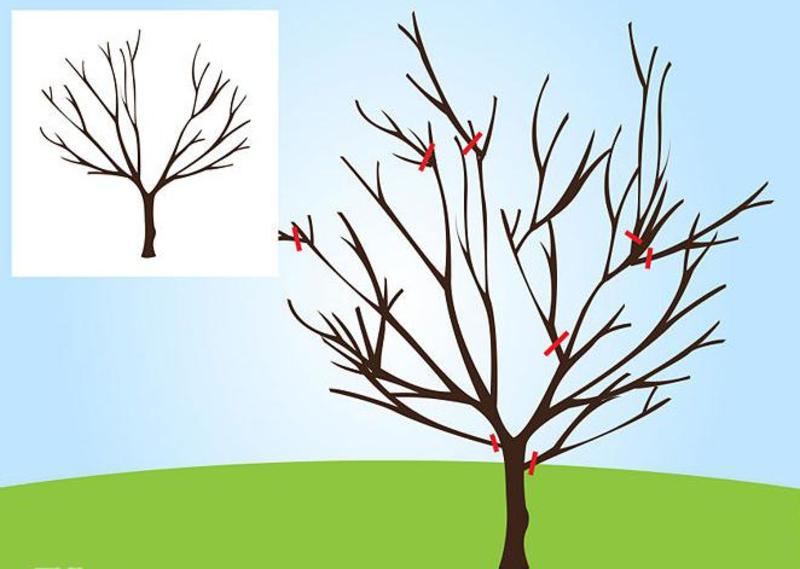

Tree cherry pruning scheme
Treelike specimens reach five meters in height. They have strong skeletal branches. Berries appear not only on bouquet branches that bear fruit over the years, but also on young shoots. With good annual growth, the trees give an excellent harvest. Cherries of this variety need to shorten young annual shoots to stimulate development and fruiting.
The growth of tree cherries should be controlled. After reaching 3-4 meters in height, the skeletal branches must be moved to another strong lateral branch.
Gardeners warn: do not remove many shoots at the same time. If the tree is in disrepair, and you cannot do without radical measures, the work must be divided into several stages, cutting off the growing branches as necessary.
Plum formation rules
Each manipulation carried out with trees has its own rules. To obtain healthy plants, to remove a rich harvest, only a garden pruner is used. It is forbidden to break off branches, this will reduce immunity. Disinfect instruments before carrying out the procedure.
Attention!
The removed branches must be burned, as plum parasites may appear there. They can spread to healthy trees, which will not have the best effect on the harvest.
Branches that grow inward must be removed, Weather conditions should be:
- dry;
- warm (temperature should be about 10 ° C).
The crown must be thinned out annually and step by step. This stimulates protection from cold weather and a bountiful harvest. Finally, you can feed with fertilizers. Top dressing of plums in autumn will have a beneficial effect on the harvest in summer.
The gardener's arsenal should contain the following tools:
- hacksaw;
- garden knife;
- secateurs.
All instruments must be disinfected before trimming. Especially if they were previously used for sick and infected crops.
Diseases can be transmitted from one tree to another. The tool must be well sharpened to prevent overshadowed cuts on the branches. Such areas will take a very long time to heal. Skeletal branches are cut with a hacksaw. A knife is needed to remove young shoots. Before work, you can practice on unnecessary rods. Less damage will be done this way.
The pruner is perhaps the most indispensable tool in a gardener's arsenal. They can remove thick branches. The secateurs must be sharpened regularly so as not to damage the cut area.
Inventory
Garden tools must be of high quality and safe to use. To carry out work on pruning trees, use:
- secateurs, for removing branches up to 3 cm in diameter and young shoots;
- lopper, for work in hard-to-reach places and at the top of trees;
- a hacksaw or a garden saw, for cutting branches over 5 cm;
- stepladder, for working on high varieties of cherries.
Garden supplies must be kept clean after work, this will reduce the likelihood of transmission of the disease from an infected tree to a healthy one. Another important condition is that the tools must be sharp in order to cut the branches neatly and without chipping.
Working with gardening gloves will protect your hands from injury. It is advisable to use latex, tarp or leather gloves.
The need for pruning
All varieties of plums are characterized by fast crown thickening. They have good regeneration, allowing a lot of side branches to grow in a short time. They pull off the flow of nutrients necessary for sowing the crop.
Several pruning is planned for this crop per year. Spring and autumn are basic.
Correct cutting of shoots, maintaining the required crown density guarantees a large number of fruits and their amicable ripening.
There are certain schemes for pruning young trees and rejuvenating old ones. It's not difficult even for beginners.
Should you prune your felt cherry branches?
One of the differences between felt cherries and other varieties is the absence of thickening growth, which simplifies the pruning procedure, but does not cancel it.
The crown of the felt cherry is thinned out annually, leaving no more than 10-12 bush shoots. Annual branches are not touched, as berries are formed on them. The exception is half-meter branches, they are cut by 1/3.
How a gardener makes pruning felt cherries is shown in the following video:
Compliance with the pruning conditions helps to increase the lifespan of the felt cherry.
Follow-up care
To support the tree after the procedure, it should be well cared for. It consists in abundant watering with the addition of complex fertilizer, cleaning the cut sites and processing them with garden pitch, loosening and mulching the trunk circle with crushed bark, peat, and wood chips.
Feeding with organic matter is allowed, wood ash containing potassium and phosphorus is especially effective. These elements accelerate regeneration and increase frost resistance. Ash is dissolved in water at the rate of 1 tbsp per bucket or sprinkled on top of the trunk circle.
Pruning plums in autumn prolongs the fruiting period, improves the air permeability of the crown, and gives the tree a chance to survive the winter without frostbite and broken branches. In the spring, all that remains is to remove damaged shoots and look forward to a bountiful harvest.

